

The Hybrid Report
DESIGNING FOR THE NEW HYBRID WORK ERA


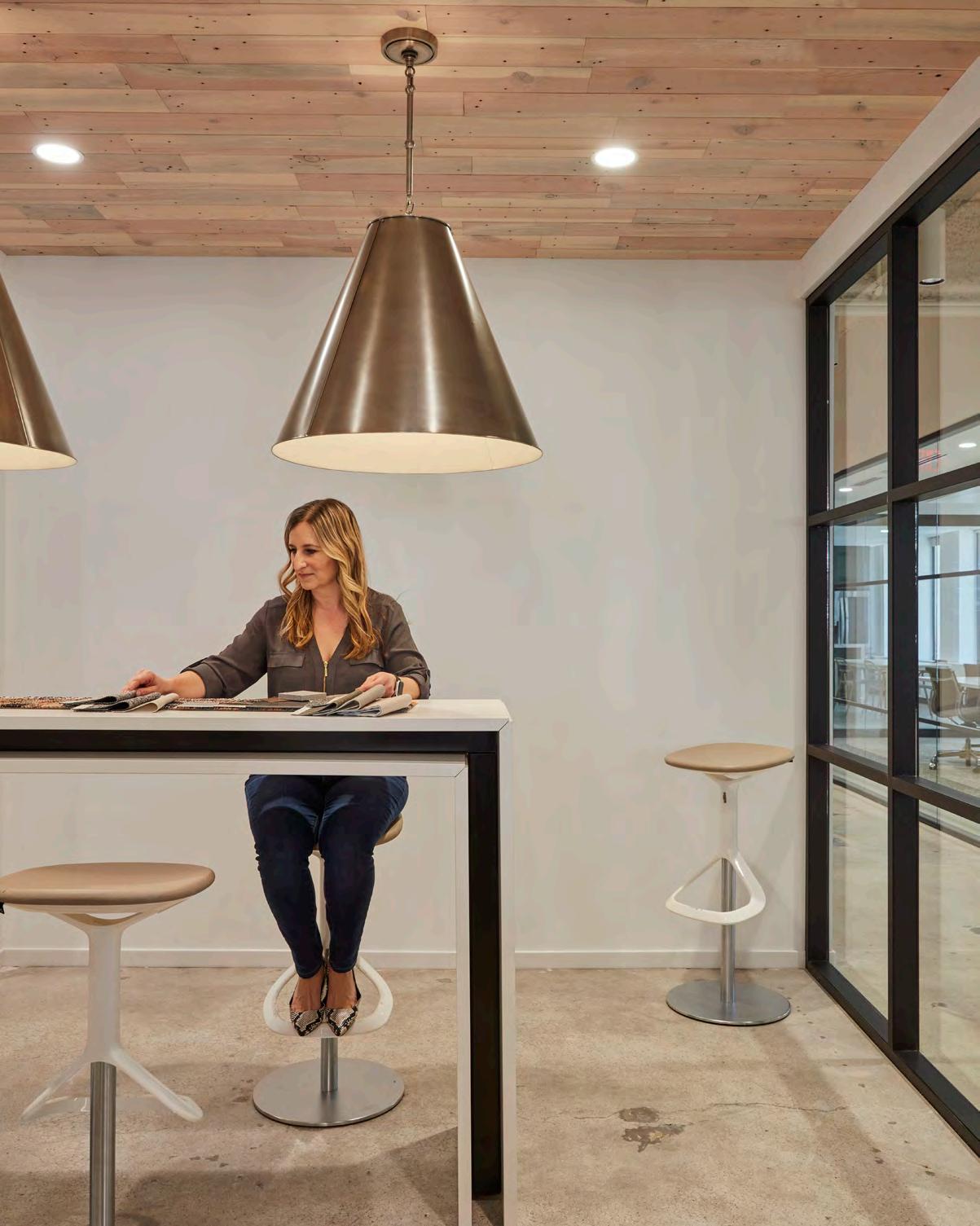
Executive Summary
The office has always required agility, but in this time of rapid change, companies aren’t just making incremental shifts to meet their goals. They are having to rapidly build new systems by thinking out of the box — literally. As employers have navigated how to respond to these immediate shifts over the past several years, they have also had to balance workforce preferences and business needs to shape how they will operate in a post-pandemic world. But as we continue to integrate modern technology with modern business, where and how we work will continue to evolve, challenging designers to create impactful spaces today that are also change-ready for the future.
Corgan has been periodically investigating the future of work — from how to tackle and incorporate new technologies ( Work. Place. Blurred) to what lifestyle shifts and demands of a changing workforce mean for the office ( Workforce Blurred). This series aimed to understand how we can
create a hybrid workplace that can facilitate both a valuable in-office experience and support a flexible digital experience.
This installment, The Hybrid Report, seeks to address employee and leadership decisionmaking drivers, identify the importance of workplace culture and relationships, understand what office affordances ultimately impact the human experience, and how design can support a seamless physical and digital workplace. Through 45 interviews with executives, managers, and HR leaders and a survey of 1,000 knowledge workers, perspectives on workplace amenities, technology, and productivity were gathered and compared for generational, role, and industry differences. This report combines data-driven insights with emerging opportunities for practical interventions and design solutions for a more flexible, supportive, and empowering future workplace.
Determine topic
Contextual research
Prepare research methodologies
Identify research participants Quantitative Qualitative Archive Reporting Themes Guidelines Differentiators Standards Expectations Architectural implications
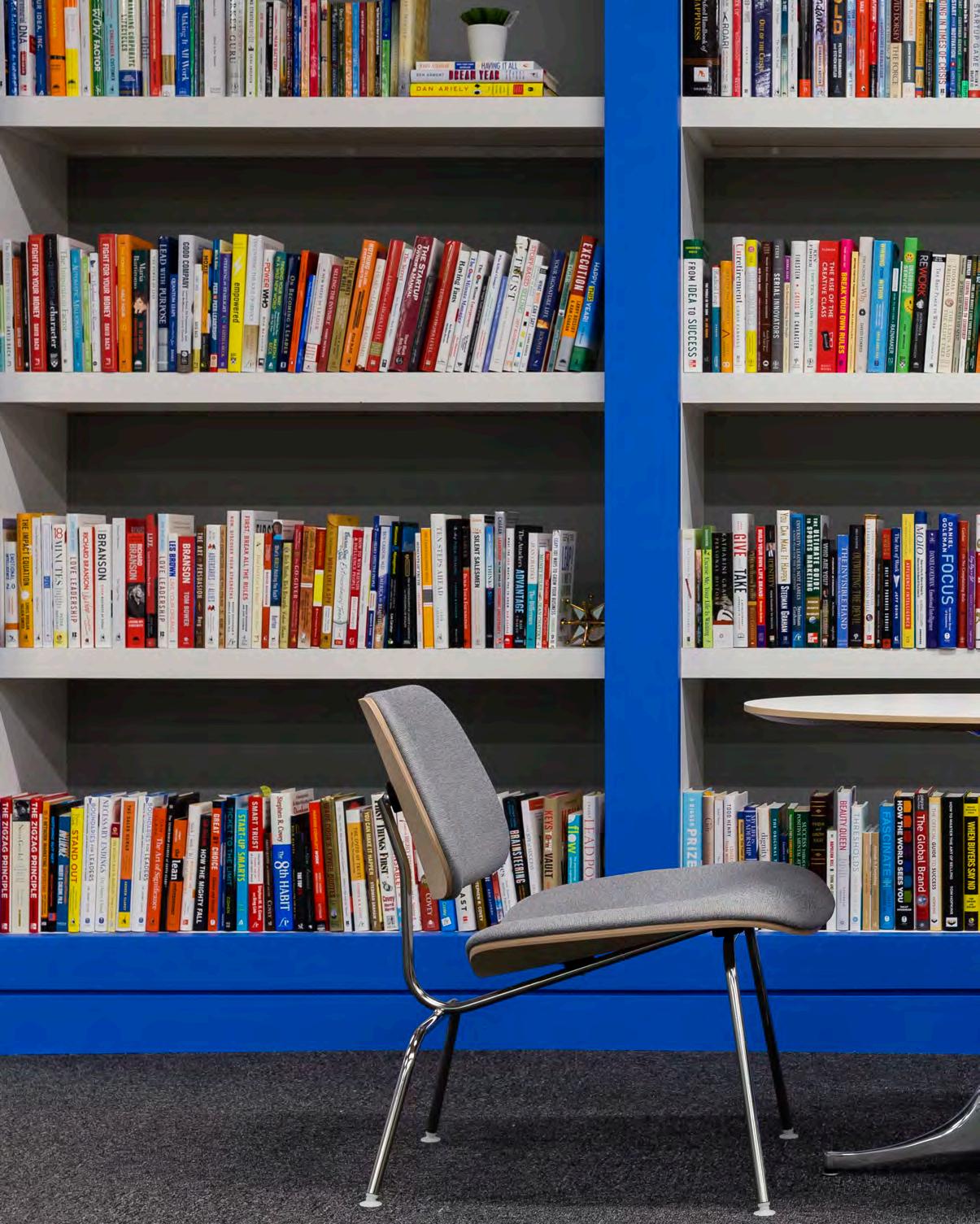

Research Context
Research Context
How can the design of a hybrid workplace support the employee experience?
In our 2021 Workforce Blurred study, we asked the incoming workforce to review hypothetical job offers with varying degrees of flexibility. The majority of participants indicated that flexible location was important to them, while none selected the option of working remotely full-time.1 In a study on the entire U.S. workforce, Accenture found that 83% believe a hybrid workplace is the ideal working environment.2
The workforce isn’t the only stakeholder seeing the value of hybrid for the future of work.
74% of U.S. companies have currently adopted, or plan to adopt, a permanent hybrid workplace.
3
As companies embrace flexible work policies, the design of the physical office becomes increasingly significant in supporting this transition and new approach to work. And as architects and designers, there is an opportunity to reconsider how environments can draw employees in by meeting individual needs and preferences, facilitating culture and relationship development, and supporting productivity, while also providing the necessary affordances for seamless connectivity between environments and workers.

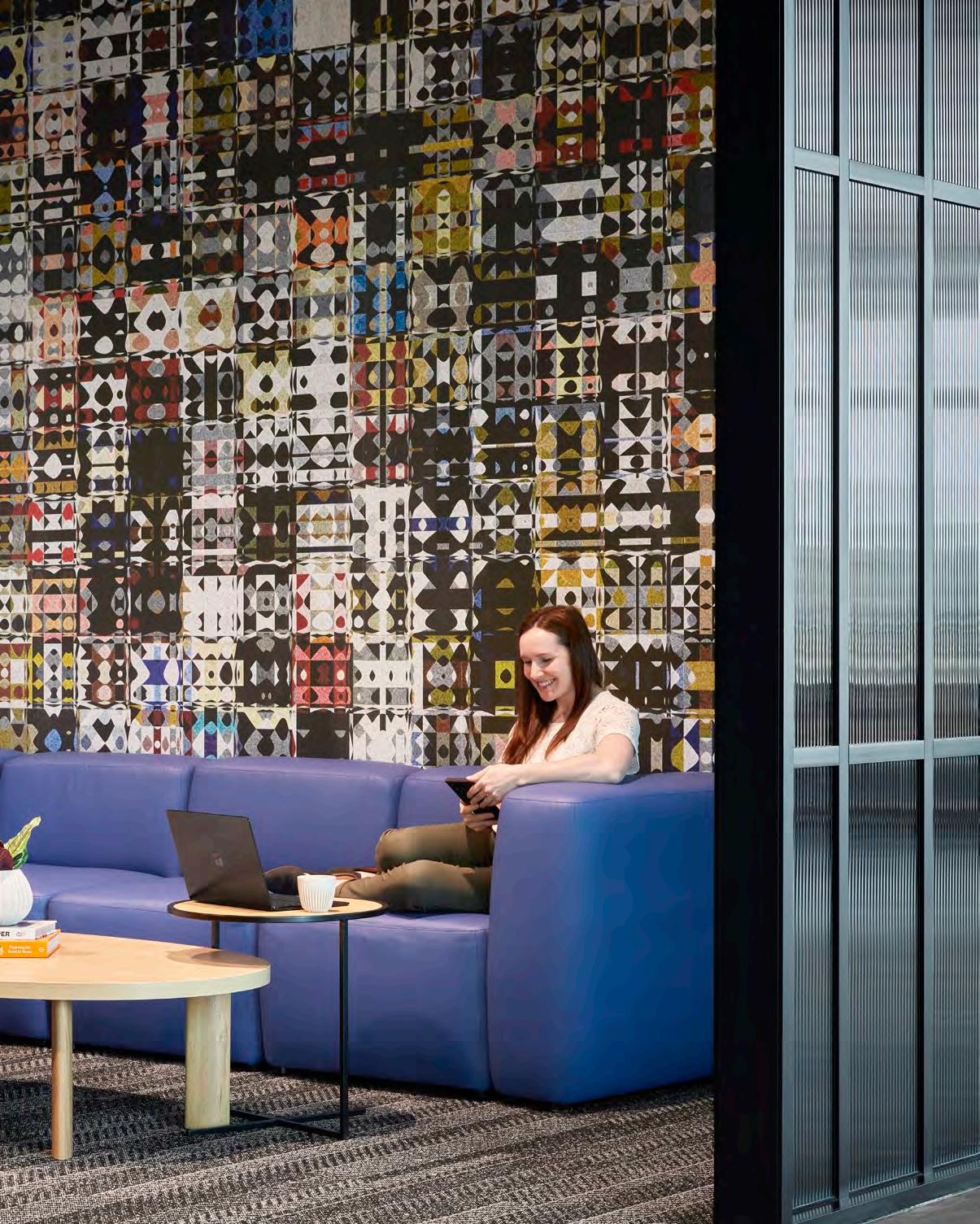
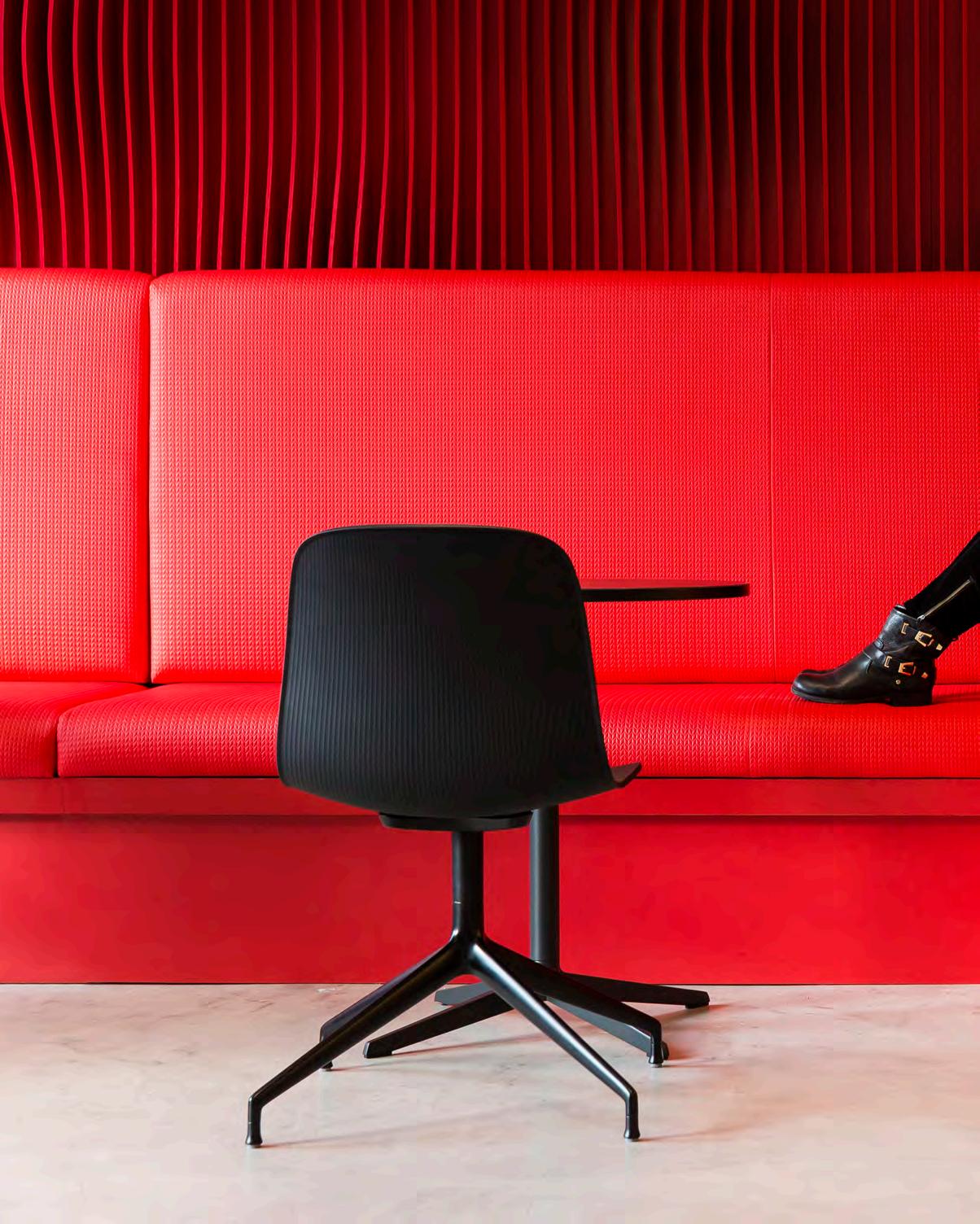
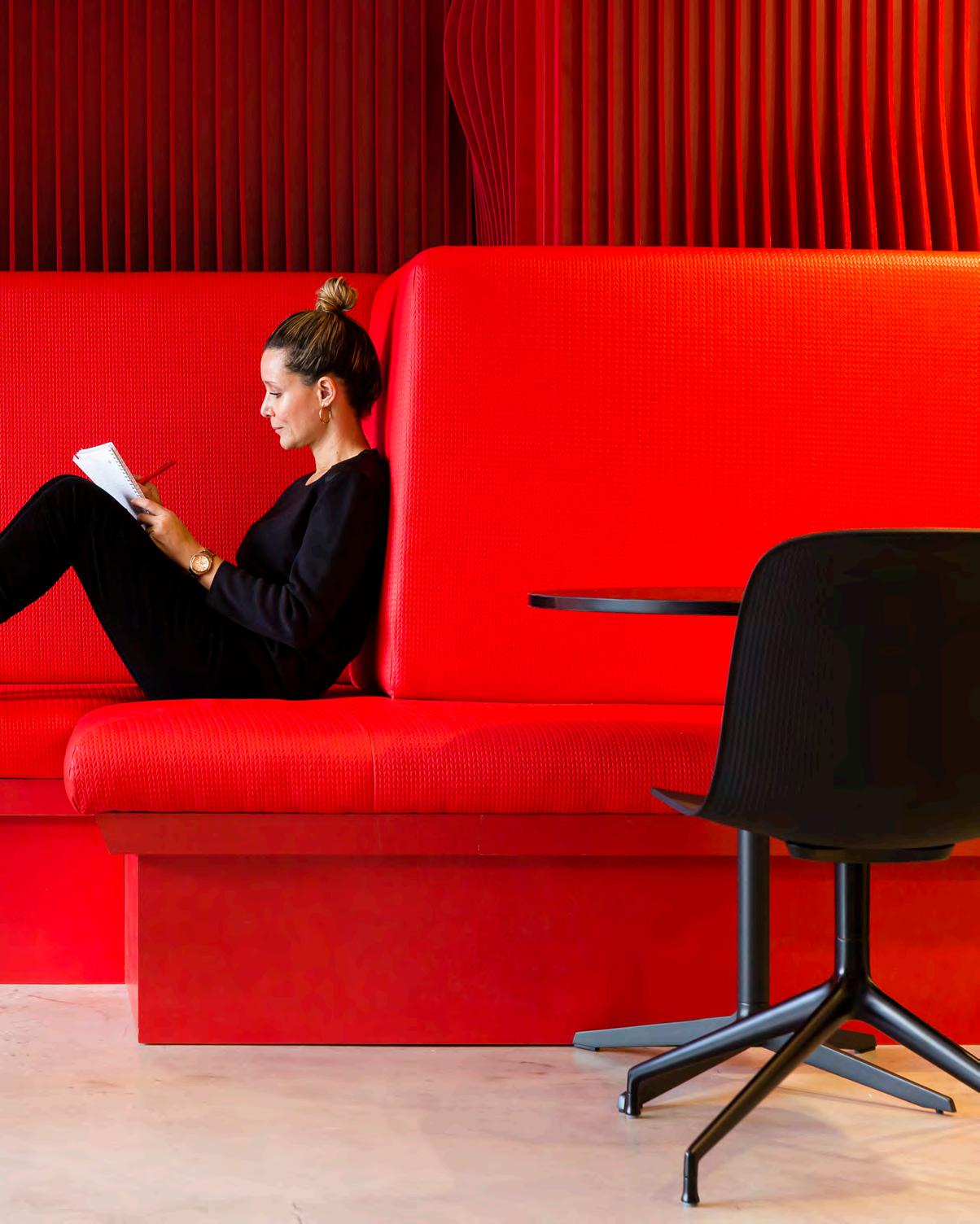
Leadership Insights
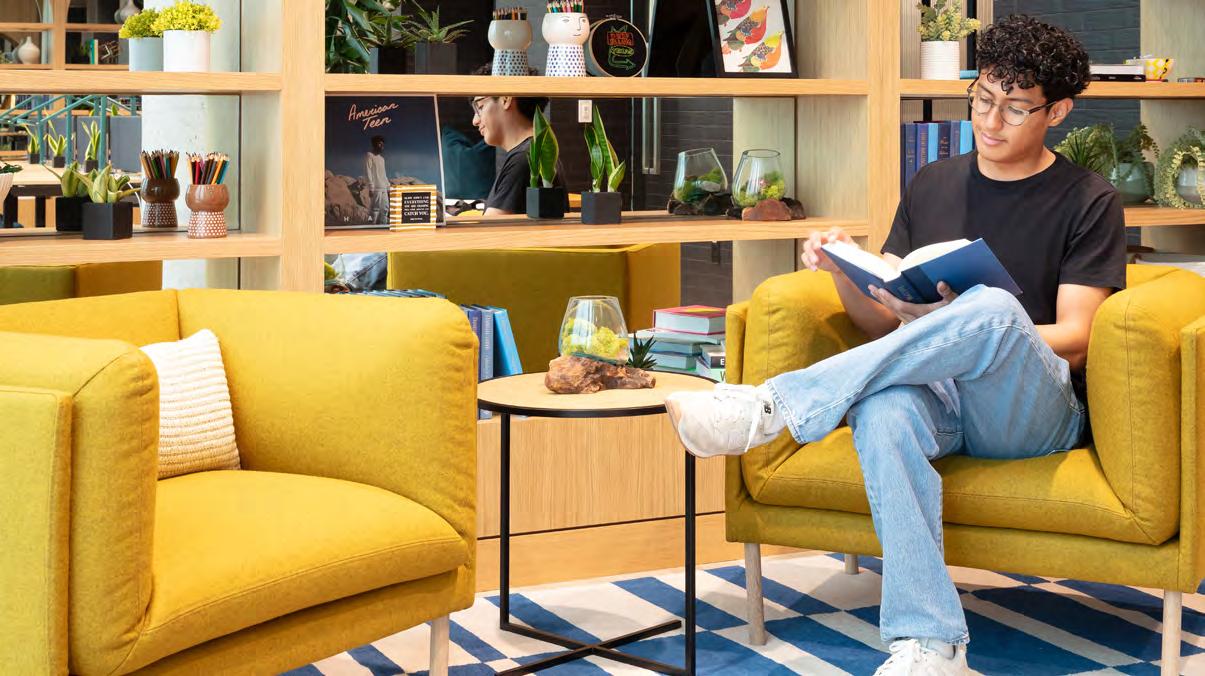
Methodology
In order to build a deeper understanding of what drives leader decision-making and how they define a successful workplace, a series of 45 in-depth interviews were conducted with leaders across the United States. These leaders were recruited from industries that included knowledge workers currently working in hybrid work environments. Participants were identified and interviewed
through a third-party platform, targeting executive leaders, managers, and human resource professionals.
With over 40 hours of recorded anecdotal data, key insights and emerging opportunities were identified and used to inform a large-scale survey of corporate knowledge workers.
15 Hybrid Executive Leadership 15 Hybrid Managers 10 Hybrid HR Professionals
Impact of Hybrid Work on Companies
While the initial adoption of hybrid work emerged as a result of the COVID-19 pandemic, its impact has been widespread on companies across many industries.
Employers rate overall employee engagement 4.06/5 since implementing a hybrid work environment.
This shift to hybrid work models offers flexibility and adaptability, as well as increased employee satisfaction with work-life balance and reduced commute time and costs. For companies, there have been both benefits and challenges of implementing hybrid work models and policies. Hybrid work presents companies with the benefit of increased flexibility and access to a wider pool of talent while also posing challenges in implementation and ensuring employee wellbeing.
“Word is getting around that we are permanently hybrid, there’s a lot of flexibility, and there are people who we are now able to recruit that we weren’t able to recruit when we were 100% in office.”
VP OF FINANCIALS FINANCIAL COMPANY
When speaking with hybrid leadership, there are challenges they face in implementing hybrid work policies. The first is how to offer flexibility as a benefit that requires accountability, ultimately posting flexibility as a privilege. Direct people managers are struggling with managing teams of employees who respond and work differently while offering the same level of flexibility for
everyone. The second challenge is successfully implementing not only flexible working location, but also flexible working hours. Many recognize the benefits it can bring, but face challenges in successful implementation while maintaining team coordination and productivity.
Another major drawback leaders are seeing for employees is the challenge of setting and maintaining personal boundaries for their overall wellbeing. They mentioned that their employees often find it difficult to switch “off” from work, struggling to find a balance between rigid boundaries and none at all. Leaders also have noticed a marked change in the utilization of days off — the more you give, the less people take. This situation echoes the phenomenon observed in large tech companies that provide unlimited paid time off — the more freedom granted, the less likely people are to utilize it. With flexible work arrangements, the amount of options lead to a reluctance to take mental health days or time off when feeling unwell, resulting in employees working through sickness or neglecting self-care.
“They should be called personal leave days instead of sick days… there are specific things people need to do to reset their minds. When we put labels on it, we are taking away their ability to take care of it.”
OPERATIONS
MANAGER
PROFESSIONAL SERVICES COMPANY
Drivers for Decision-Making
In our interviews, we discussed with leaders their drivers for working in-office or remotely each day, and how they support team-wide decision-making. Leaders shared that they primarily make personal work decisions in response to their teams’ plans — making sure to be available and present when they are in the office, but to also protect their focus time as needed. This is due in large part to collaboration benefits that leaders and managers are seeing when staff are syncing their schedules with each other but also the motivation developed when collaborating and seeing others working as well.
ADVANCED PLANNING
Due to this, leaders are working to find a middle ground for staff flexibility by better setting
expectations in their company hybrid policies that help promote these collaboration benefits to occur while ensuring work continues smoothly. This move away from “day-of” decision making is in part due to “downstream and upstream” considerations for success. By having advance notices from employees on their flexibility plans (~2 days to 2 weeks ahead of time), leaders are able to see the larger downstream and upstream implications of when employees want to come into the office. For example, they can maximize plans for collaboration when teams plan to be in office through advance planning instead of same-day notice, which takes away that advantage. Conversely, leaders who rely on day-of coordination have expressed struggles in optimizing their collective time and efforts.
“You want people to sync their schedules when they are in a relay race, working upstream and downstream from each other. More difficult in Teams than in being physical proximity for transparency.”
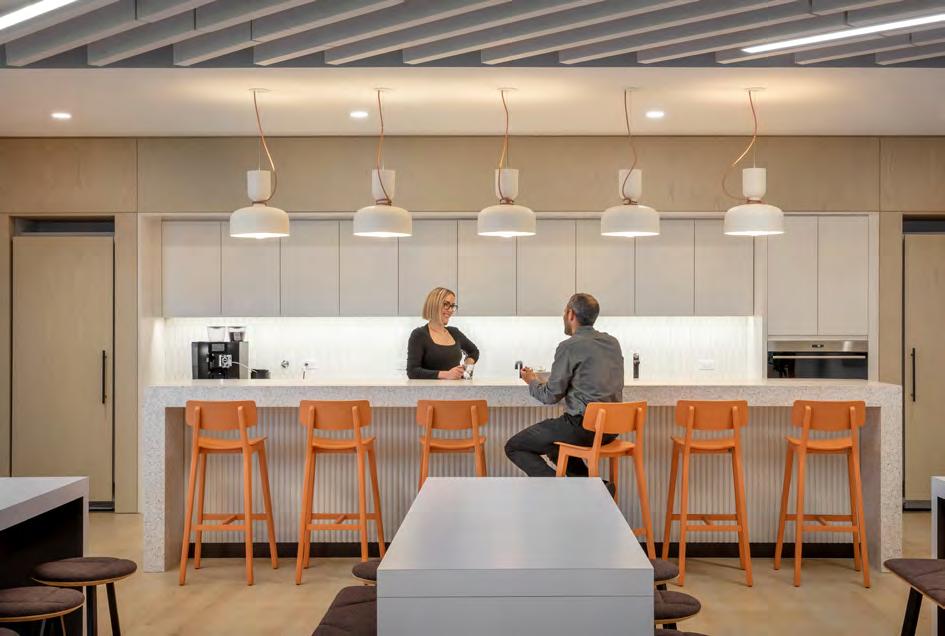
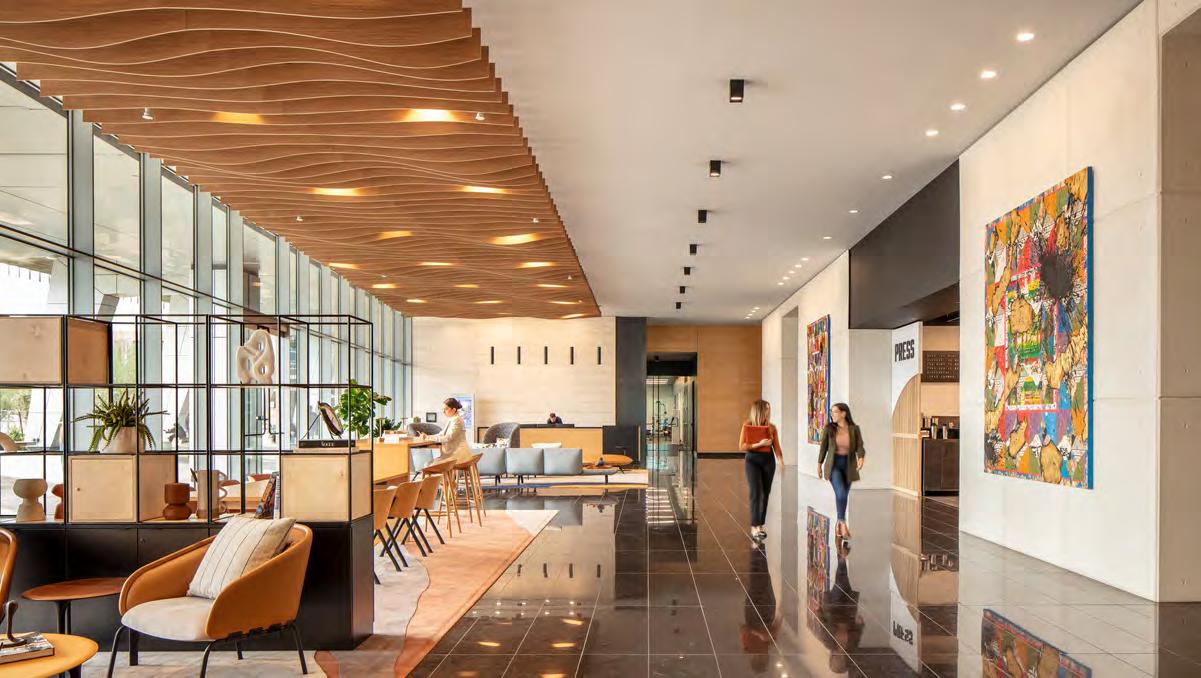
DEFINING THE ROLE OF THE OFFICE
For interviewed leaders, the evolving value of physical office spaces is shifting towards fostering collaboration and social engagement, emphasizing the importance of relationship-building activities. However, this focus on collaboration can inadvertently lead to a minimum attendance mindset for staff, as individuals may opt for remote work if they cannot also accomplish focused tasks in the office. Leaders have indicated that performance is increasingly measured based on the ability to effectively complete work, making remote work more appealing if the physical office environment lacks desirability.
When considering their current space, leaders feel it is crucial to consider this dynamic when designing both the physical workspace and the social aspects within it. The challenge lies in finding ways to signal availability and focus, striking a balance between collaboration and individual productivity. The
current “bare minimum” approach of attending the office, coupled with employee turnover, has resulted in the loss of a sense of community. Relationships that were previously established have been severed as individuals leave, and they are not being rebuilt in the same way when employees are predominantly focused on their individual tasks. Leaders feel this speaks to a need for in-person culture and relationship building, highlighting the need to carefully consider the design of physical spaces and social dynamics to foster a more balanced and inclusive work environment.
“I
think it’s been tougher for the new people; I think it’s harder to build their network in the hybrid work environment. It’s taking them a bit longer”
Workplace Design
In interviews with leaders, valuable insights were gathered regarding the current and future needs for office design. These discussions shed light on evolving priorities and considerations when it comes to shaping the physical work environment.
TEAM-BASED PLANNING
Team-based planning is gaining prominence among leaders for the design of physical work environments, with a shift towards creating spaces that cater to the needs of teams rather than individuals or open areas for multiple teams. Leaders emphasize the need for designated areas where teams can work together seamlessly, fostering collaboration and open communication without distracting other teams around them. These spaces should facilitate brainstorming sessions, group discussions, and cross-functional collaboration, enabling teams to share ideas, solve problems, and make collective decisions.
“Visibility
to each
other is very important. More meeting space
is important as many people come to the office specially for meetings and collaboration.”
MANAGER, IT FIRM
However, leaders indicated that it is essential to provide both privacy and the opportunity for open collaboration within teams without disrupting others. Providing private spaces within team-based environments is important to support individual focus work. These quiet areas or individual workstations allow team members to concentrate on complex tasks, engage in deep work, and meet deadlines without distractions. Balancing the need for collaborative spaces with dedicated areas for
individual focus work promotes productivity and supports different work styles within the team. By incorporating these dual-purpose spaces, organizations can create an office environment that encourages teamwork and individual productivity, leading to enhanced performance and innovation.
CYCLICAL AMENITIES
Amenities play a significant role in attracting people to the office, but leaders have shared that their impact extends beyond a one-time effort. It is essential for organizations to recognize that amenities should be considered cyclically to maintain the “awe” factor and continue drawing employees to the office.
By continuously refreshing and improving amenities, organizations can ensure that the office remains a draw for employees. This approach goes beyond functionality; it aims to create an atmosphere that fosters creativity, collaboration, and overall employee wellbeing.
“The amenities provide newness. Every year or so brings forward something new. None of them will last… how do we implement that into the design of our office setting? How do we keep inciting desire to come in for something new or fun?”
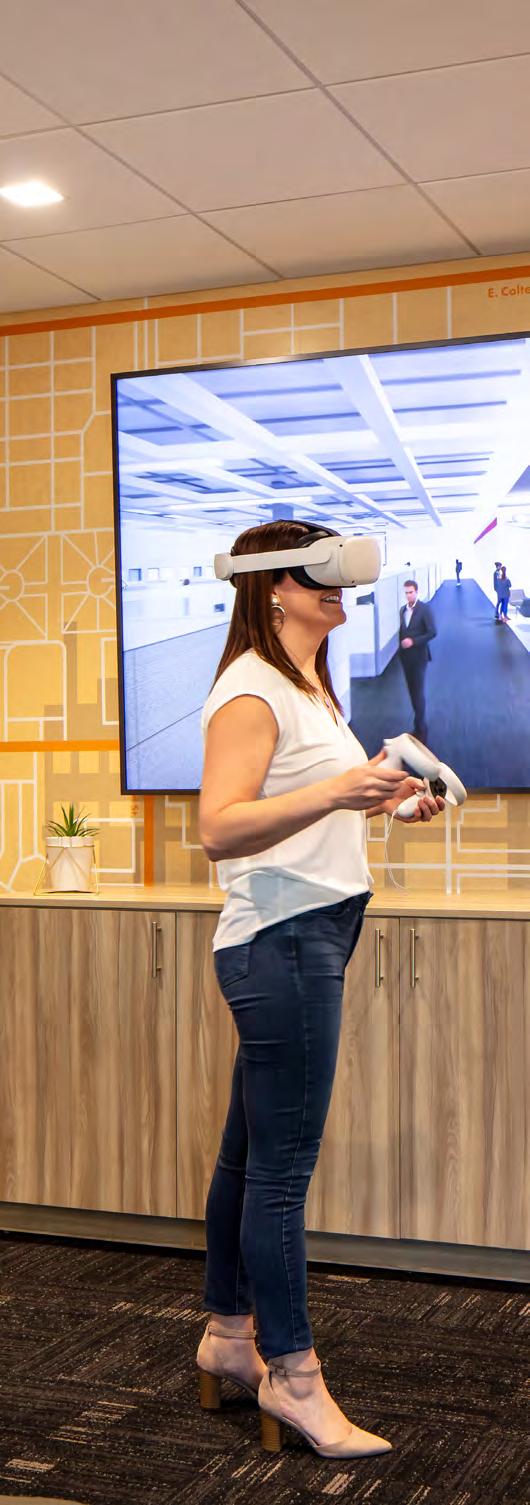
ROLE OF TECHNOLOGY
With the adoption of a hybrid work environment, technology’s role in the office is becoming increasingly important to connect the physical and virtual. However, leaders have shared that the unknown of technology’s functionality is a stressor for teams – unreliability at personal desks or in meeting spaces makes working from home a more appealing option. Leaders recognize and recommend needing more preventative checks from IT on the state of technology in the office, on-demand support for immediate needs, and feedback opportunities to keep needs and concerns from staff communicated.
“Technology has helped the company to improve its communication and how the company operates.”
COO, REAL ESTATE COMPANY
While much of the current focus is on maintaining technology, leaders have shared that they also are looking to technology needs in the future as the possibilities are endless. Many have indicated that their companies are open to exploring advanced technologies, but the vetting of these is key to be sure it offers value and can gain user comfort from their staff, especially when it comes to the metaverse. Implementation also presents a challenge at the decision-making level due to affordability and the time required to address security concerns of the technologies.
“These technologies will need to have a degree of separation [from reality]… People think there will need to be a convergence where the metaverse should be very lifelike. But we will always know that there is a degree of separation. It will always be that Polar Express effect.”
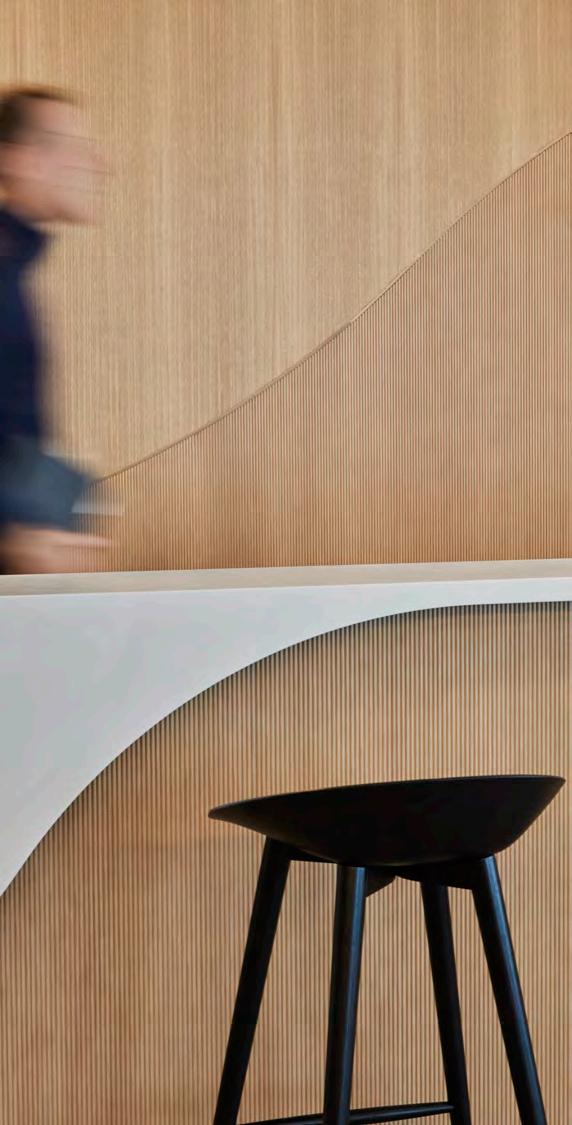
Revisiting Metrics
The shift towards a more flexible workplace brings about a significant change in our approach to measuring results, emphasizing the importance of results rather than physical presence.
In our conversations with hybrid leadership, we asked them how they were redefining workplace metrics in a hybrid environment as we shift away from full-time occupancy in the office. While understanding physical presence helps in strategic decision-making to right size support staff and space needs, it no longer served as an indicator of a successful work environment. So, what does?
While some indicated that they consider employee metrics, such as a strong connection between employees, the main metric of a successful workplace, to hybrid leadership it is task completion and overall productivity. While this was a key metric before, it has become increasingly important with the implementation in the hybrid workplace as it indicates success regardless of location.
“It’s more about getting the research and work done. It’s more about results than stringent hours.”
This shift has proven beneficial in achieving immediate project tasks that can be easily measured. Hybrid leadership also feel that the time benefit of task completion, or burden of task avoidance, should be given back to the employee. If a task can be completed more
efficiently and quicker than expected, employees should be incentivized with the benefit of returned time. If a hybrid worker, doesn’t keep up with their work, it is their responsibility to make sure they ultimately get it completed within their flexible, personalized approach.
“The ability to keep up with what they’ve designated as their workflow… We have an environment where you dig your own grave and have to get out of it every time.”
However, hybrid leaders feel there has been a marked loss in progress towards larger goals and long-term projects with this specific focus. As remote work becomes more incorporated into the typical work week, it lends to a more siloed work environment where individuals primarily focus on achieving short-term project objectives.
Hybrid leadership often operates with a greater degree of foresight, knowing what changes or projects are coming down the pipeline, and are responsible for progress towards long-term objectives, requiring a stronger physical presence. Additional visibility and engagement is often needed for leaders to make well-informed decisions that strike a balance between their work and the work of their team. Individual hybrid workers tend to be more task-oriented, concentrating on the “now” and demonstrating productivity through the completion of immediate assignments.
The key is to find a balance between the “now” and the “future” between role types to maintain immediate productivity while also driving growth and success over time.
“Productivity matters. Occupancy has some correlation to long term goals and vision setting but does not indicate success in short term work.”
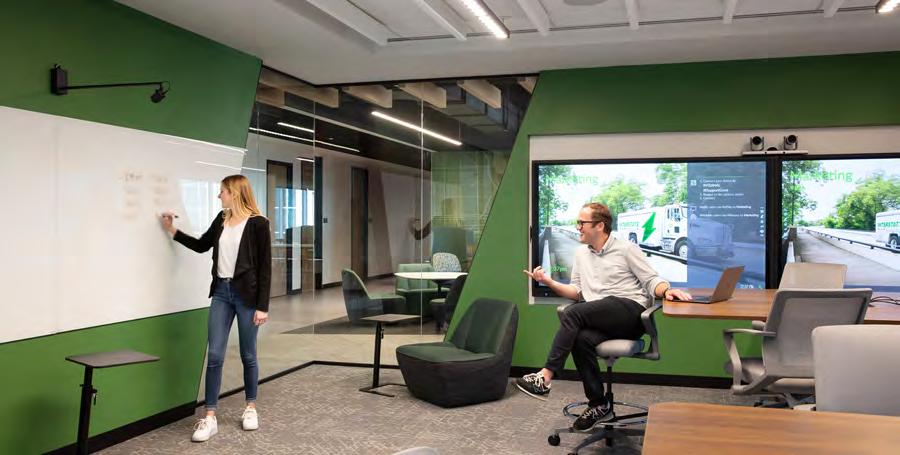
Findings from Leadership Interviews
01 ONE-SIZE-FITS-ONE APPROACH
Hybrid teams function differently, and leaders are struggling to find ways to meet their specific team needs. Instead of a “one-size-fits-all” approach to hybrid work, people managers need to take a more custom, personalized approach to confirm their teams’ needs are being met.
02
MAINTAINING “AWE” FOR IN-OFFICE APPEAL
Amenities are being used as an incentive to draw people back to the office. However, these aren’t a one-time effort — they need to be reconsidered cyclically to maintain an “awe” factor.
03 BEYOND COLLABORATION
Many company leaders are focused on collaboration being the main driver for coming into the office. Other key drivers include motivation, passive mentorship, relationship and culture building, and productivity. Everyone is getting used to the new office and how to best use it.
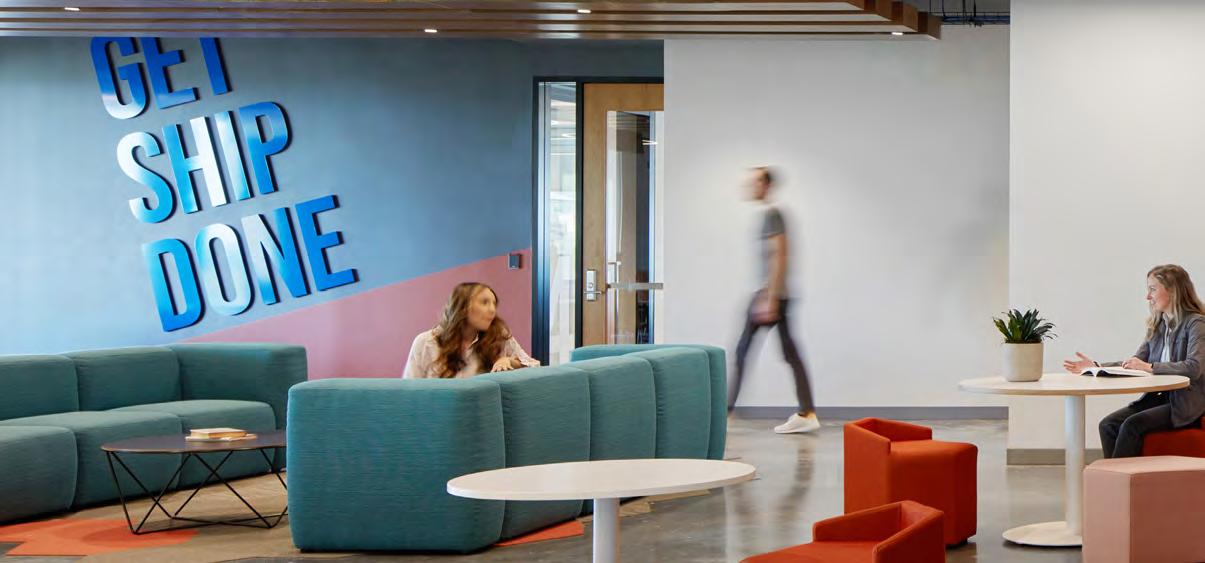
04
THE NEW SUCCESS FACTOR
There is a shift in talent that is succeeding in the hybrid work environment — in addition to technical skills, soft skills are needed to make sure they are independently motivated and can contribute to the desired culture. Investing in development and skills-building is important for overall success.
05 DESIGNING FOR MOVEMENT AND CONNECTION
Metrics for success are changing and measuring overall productivity is becoming more indicative of that success than simply in-office occupancy. Performance is being measured by the ability to complete work and the office can better support this. Employees prefer the ability to be collaborative and connected.
06
TEAM-BASED PLANNING
Teams and individual focus are becoming the base unit for planning instead of open work areas and social areas. Teams need privacy and the ability to work openly together without bothering others, while also having access to the necessary environmental qualities for individual focus.
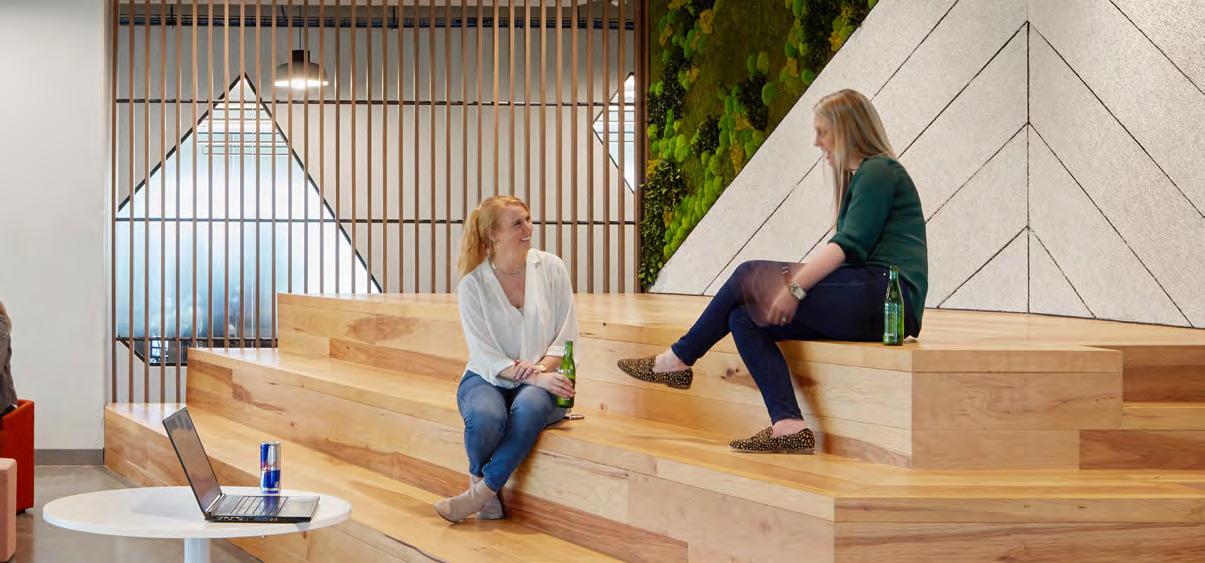
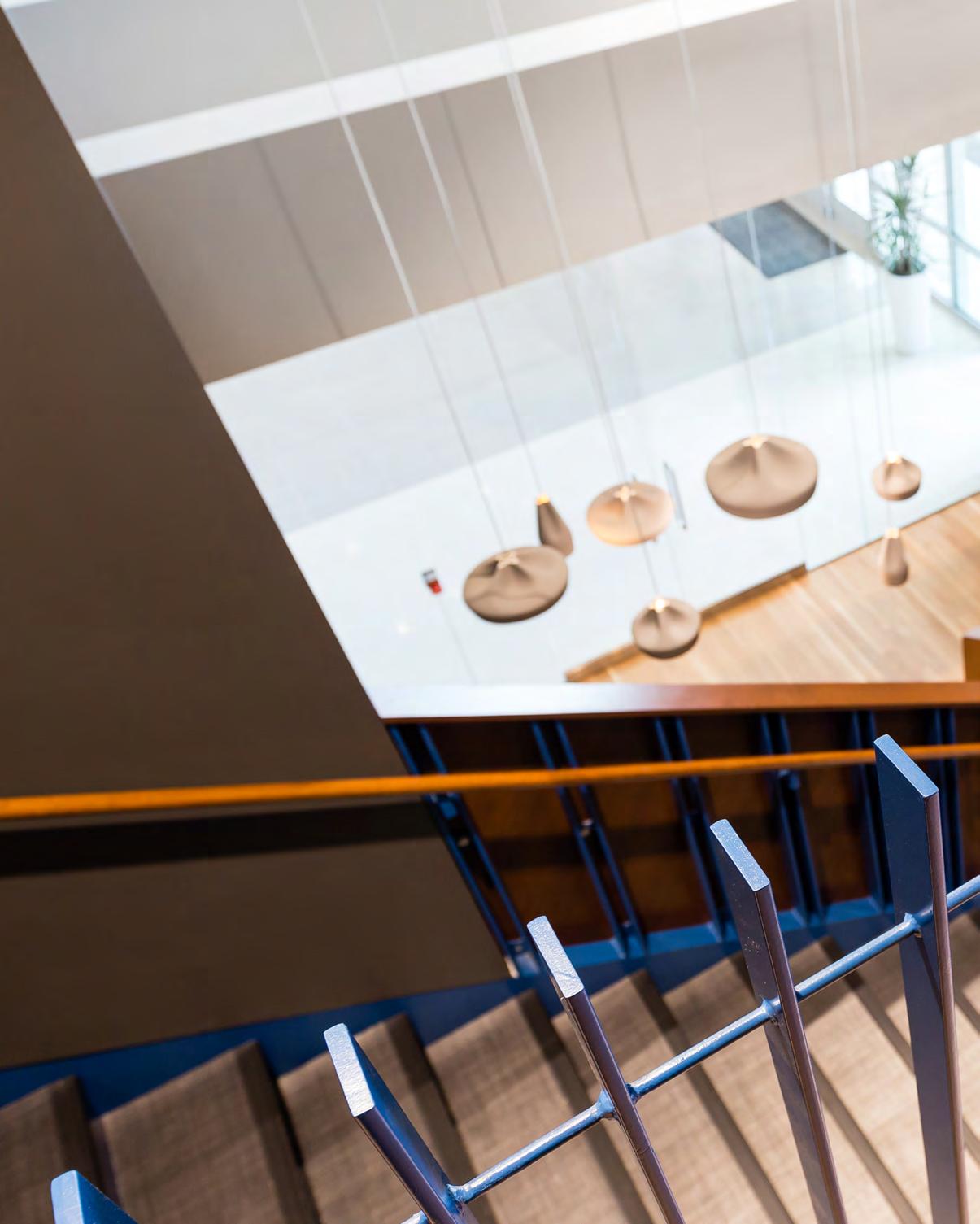
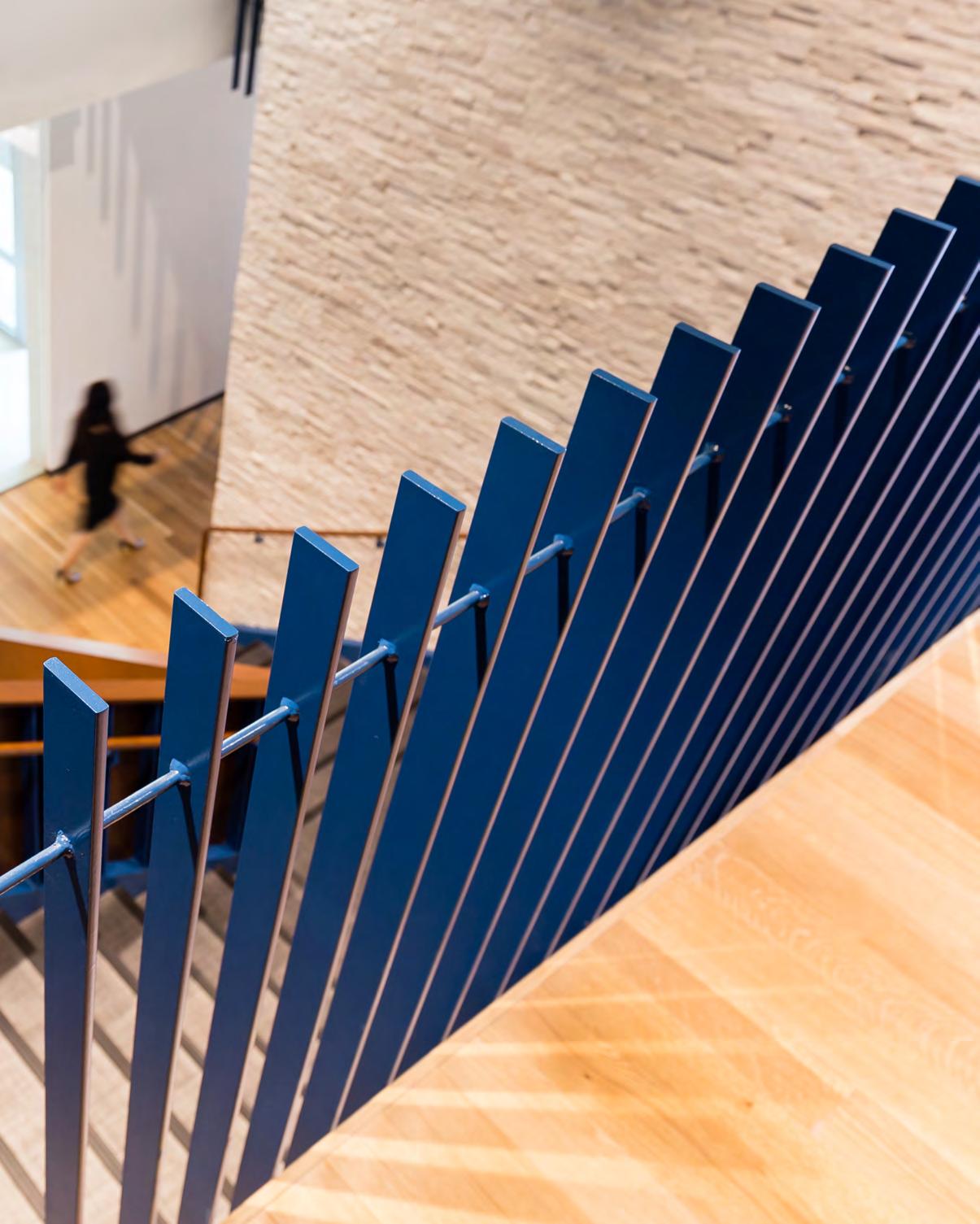
Workforce Insights
Methodology
A nationwide survey was conducted to understand current state of the workplace and how the desired hybrid employee experience can be better supported. This survey was done through a third-party survey provider to target 1,000 full-time, corporate hybrid knowledge workers, who split their time between working in-person and remotely. The survey also targeted hybrid workers who were born either between 1965-1980 (Gen X), 1981-1996 (Millennials), or after 1996 (Gen Z).1 Survey analysis also subdivided these age groups (e.g. younger
and older millennials) to understand if there were additional differences within each generation.
Representation of survey participants included 47% male and 53% female. Survey participants were also asked about their level of education, of which 48% had a bachelor’s degree, 18% had an associate’s degree, 16% have some college credit, 12% had a master’s or doctoral degrees, and 6% having either some high school or having graduated high school.
Generations
188
422
390
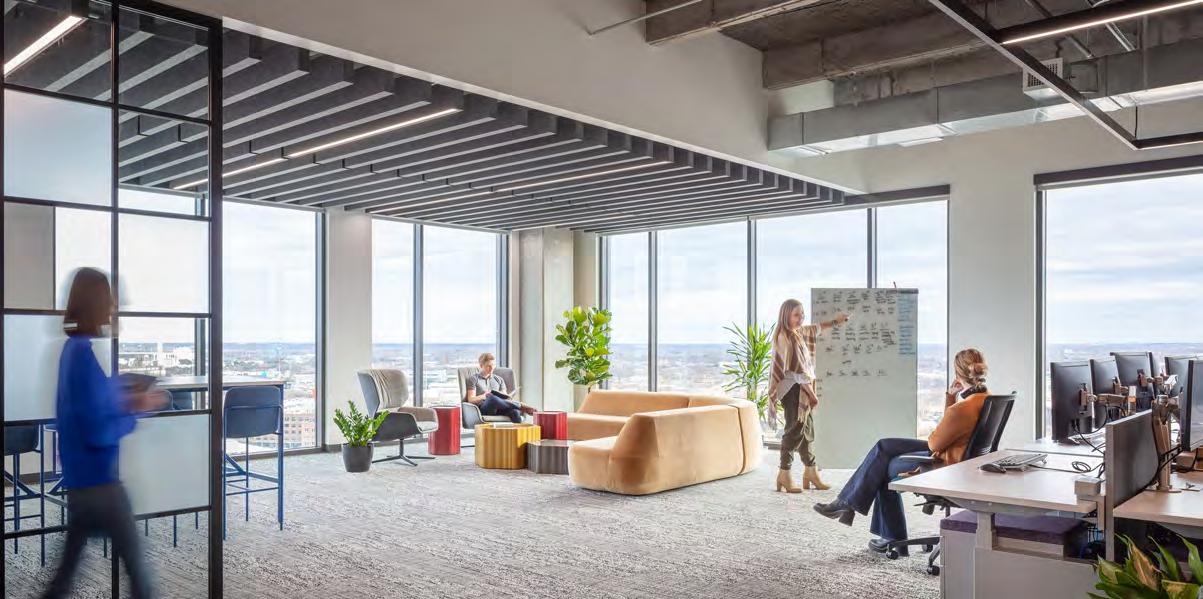
Survey participants also shared their current flexibility policy and company size
Survey participants also shared their current flexibility policy and company size.
FLEXIBLE POLICIES
100-1,000 employees (Medium)
In addition to diving deeper into concepts from our original studies, and building upon insights from our interviews with hybrid leadership, we included survey questions to examine:
■ Success of Flexible Work Environments
■ Building Relationships + Culture
■ Drivers for Decision-making
■ Design of the Physical Workplace
■ Fluidity of the Physical + Digital Workspace
■ Employee Attraction + Retention
■ Demographic information including age, gender, company size, and tenure
1,000-2,500 employees (Large)
After collecting survey responses, the data was then analyzed through descriptive and chi-squared tests to capture findings and identify relationships between various demographic factors. The chisquare test was then used to determine whether there is a significant association between two or more categorical variables. The study used python programming language to prepare and process the raw data collected from the survey. In this report, means are represented by M (e.g., M=3.4) and all findings that are called out as statistically significant satisfy p<0.05.
West: 255
South: 318
Midwest: 207
Northeast: 220
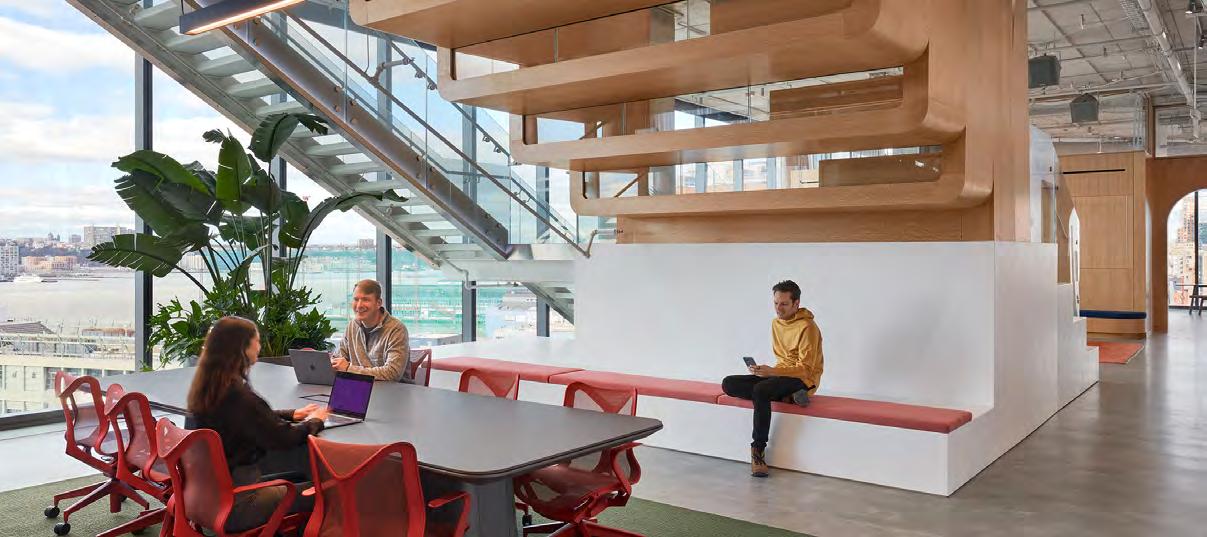
Impact of COVID-19 on the Workforce
The COVID-19 pandemic served as a catalyst, kicking off years of rapid change for the workplace and workforce. This period has created new hybrid work models that have transformed the way companies work, but this combination of remote and in-person work has also transformed how the workforce makes short and long-term decisions. The benefit of balance between work and personal has this new generation of hybrid workers deciding between living near where they work or play and choosing new careers and work models that support their personal lives.
COVID-19 and the current economy have ________ my desired industry and job title.

and the current economy have _______ my desired geographic location and how I spend my time outside of work.

For the majority of survey participants, COVID-19 did not significantly impact their desired profession or personal life. However, survey participants indicated that it had a greater impact on their desired geographic location and how they spend their time outside of work (42%) than it did on their desired industry and job title (34%). This indicates a greater impact on external drivers for decision making, such as personal lifestyle preferences, than internal drivers, such as job opportunities.
WHERE TO LIVE
It is becoming increasingly important to hybrid workers that they live near the office as compared to before the pandemic — 83% of survey participants think it is very or extremely important to live near the office, as compared to 70% before COVID-19. With the choice to work remotely or inperson, hybrid workers consider commute length, and ease of commute, more important than before.
TECHNOLOGY ADOPTION
The shift to remote work during the COVID-19 pandemic also necessitated a rapid digital transformation, with organizations adopting new
COVID-19
How important is it to you to live near the office?
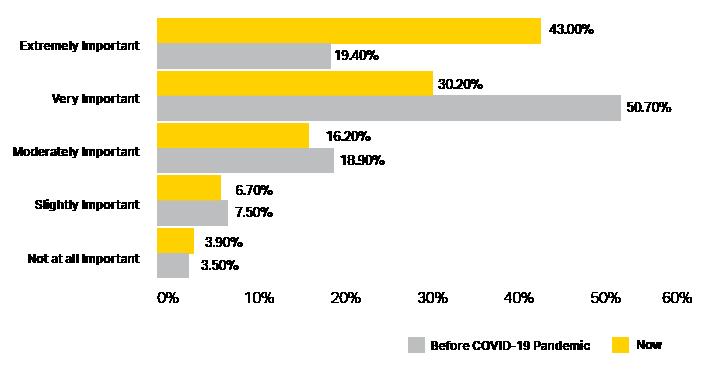
tools and technologies to facilitate communication, collaboration, and coordination. Hybrid workers had to adapt to this technology adoption and learn new “soft” skills that would help them continue their roles virtually. These new skills remain important as hybrid work continues, enabling a more seamless physical and digital work environment.
83% of survey respondents either agreed or strongly agreed that they were able to adopt new technology when starting remote work during the COVID-19 pandemic.
The majority of hybrid workers indicated that they were able to adopt these new tools when shifting to remote work. There was also no significant difference between time at the company, or between hybrid workers from different generations, and the ability to adopt technology during COVID-19, indicating long-term success and comfort for all employees using new technology to support a hybrid work environment.
MENTORSHIP
A large concern for companies during the COVID-19 pandemic — and also when implementing new hybrid work policies — is how mentorship opportunities and relationships are impacted. Virtual mentorship, while more flexible and providing expanded access to mentors, has required additional planning and consideration to facilitate casual conversations and questions that often occur passively when face-to-face, occur as frequently and comfortably as before to create valuable, personal connections.
We asked survey participants about mentorship in the flexible work environment and how it has changed since COVID-19. Hybrid workers are least satisfied with mentorship (3.95 out of 5) as compared to boundaries, policy, and professional development opportunities. For those who indicated a change in mentorship, they shared that working remotely has made passive mentorship more difficult, and now there is a focus on more formal engagement (clear mentors, scheduled time together to create goals, etc.) that helps create more equity. This shift has made mentorship a more prominent and visible aspect of the employee experience that is approached with more intention and planning than before.
“[Mentorship]
has to be much more purposeful because you don’t have the unplanned interactions you would have in the office.”
Understanding the “Hybrid Worker”
Typically work 3-4 days in the office each week

81% work at companies where they have predetermined days to come into the office as part of their flexibility policy
73% feel most productive when working outside of the office
75% agree that having a flexible work environment has improved their wellbeing
85% feel that being able to have a flexible working location is important
83% feel that being able to have flexible working hours is important
78% believe soft skills are as important as strong technical skills
31% identify as having one or more mental or physical disability that affects their experience with physical space
Are most satisfied with personal + work boundaries and policy in their current flexible work environment
As we enter this new era of hybrid work, understanding the hybrid worker — how they operate and what they want in the future — is critical for understanding the evolving work landscape and maximizing the potential benefits of hybrid work models and office design for both companies and their workforce.
For the majority of hybrid employees surveyed, their companies’ flexibility policy dictates a predetermined number of days they should come into the office.
Employees at companies without predetermined days set by the company (19% of survey participants) come into the office significantly less than those whose companies set some sort of schedule.
Hybrid workers at medium-sized companies are more likely to work more days in the office than small or large sized companies, indicating an importance of scale (both physical space and number of people). Right-sizing helps the in-person experience to be more personable and navigable while fostering connection and culture.
All generations of hybrid workers equally value flexibility in time and location. However, they are less likely to be satisfied with their ability to work outside of a 9-5 schedule (4.16 out of 5) than their ability to work in another location (4.24 out of 5).
Skills for success are also changing. The majority of surveyed hybrid workers believe that having strong soft skills (e.g., interpersonal skills) are just as, or more, important than having strong technical skills. This indicates that success is not only dependent on rolespecific skills but being able to work collaboratively and productively.
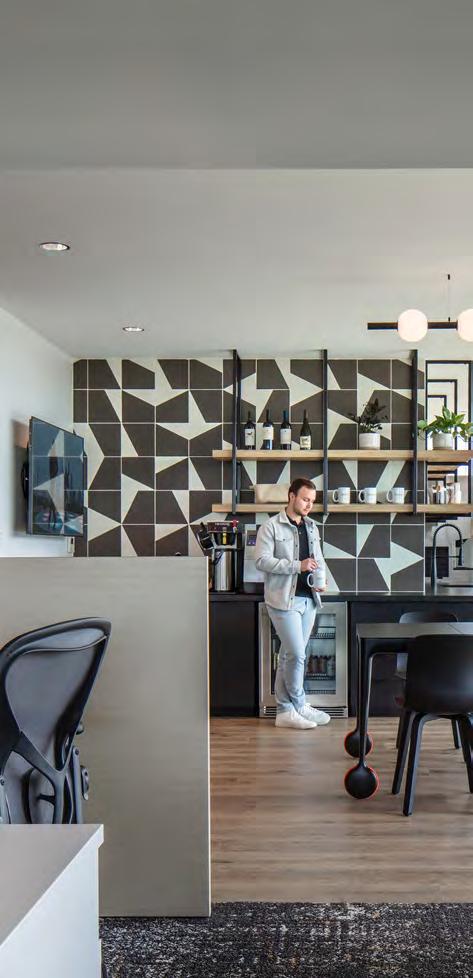
“A workplace has to be one of two things or both — it has to be productive or collaborative. And they have very different success measures.” VICE PRESIDENT FINANCIAL SERVICES ORGANIZATION
Building Relationships + Culture
75% of people make their friends through work, and when employees only have a few friends at work, they report a 71% stronger intention to quit, as well as increased anxiety, depression, burnout and stress.2
While survey respondents rated their personal connection to professional colleagues as close (3.96 out of 5), they desire more connection in an ideal state (4.26 out of 5).
This is a significant difference (p=2.4e-20) between current and ideal state for the level of personal connection to the professional colleagues. So how do we foster better relationship-building at work? While hybrid work challenges us to connect through multiple modes, 74% of hybrid workers feel more engaged with colleagues and workplace culture when working from the office.
Design in the workplace matters for bringing people together and supporting better relationships, and overall culture. When talking about personal relationships, 77% of hybrid workers believe the design of the workplace is important for building relationships with their colleagues, which can lead to trust and retention. This is rated even higher for Gen X millennials and hybrid workers at larger companies, which likely have more space variety and offerings to support engagement with colleagues.
Humans build relationships in space, experiencing things together — creating bonds and memories. While this benefits individual relationships, the resulting increase in communication, respect, and support of one other also creates an improved workplace culture for all. 76% of survey participants believe the workplace design is important to culture.
In addition to space that provides variety and unique experiences, space for spontaneous conversation and collaboration is desired by 69% of hybrid workers. This may be informal for impromptu conversations, such as wider hallways, but also dedicated team break-out space that fits everyone.
63% of survey participants shared that they need established boundaries to be able to “turn off” outside of work.
BOUNDARIES
Strong relationships require strong boundaries, establishing trust and balance for individuals and teams. However, just setting boundaries is not enough. A plan to communicate and maintain these boundaries predicts their success. 84% of survey participants say the boundaries they set in a flexible work environment are successful. The most common boundaries set include personal planning, clear communication, set time, allocated space, and separation from others/non-work matters.
MOTIVATION + PRODUCTIVITY
The presence of others is a key source of motivation, 76% of survey participants either strongly or somewhat agree that they feel more motivated working in a group or seeing others around them being productive. This effect has been long studied by social psychologists and not only impacts people’s actions, but it also how they perceive those actions and their value.3 When being watched and watching others, people tend to work and think harder, and are more creative — but an individual’s investment of time and energy feels more meaningful in the presence of others, creating additional motivation. This is equally important to
the physical design of the workplace, with visibility between colleagues, but also in how people engage with one another, making their accomplishments and work more visible.
While motivation serves as a driving force, productivity means that efforts are efficiently used to achieve desired outcomes. 73% of survey participants indicated that they currently feel most productive when working from home or at another location outside of the office.
However, hybrid workers also view the current in-person workplace as an environment designed primarily for productivity versus an environment that is ideally designed for connecting with others.
So, while offices can, and ideally should be motivating and productive, there is a misalignment between what hybrid workers want the workplace to be versus how it is currently working for them. When asked about their current office design and what drives their decision to work at the office, having access to private focus space was the lowest ranked driver. Workplaces need to meet the environmental qualities people desire, and need, for even better productivity.
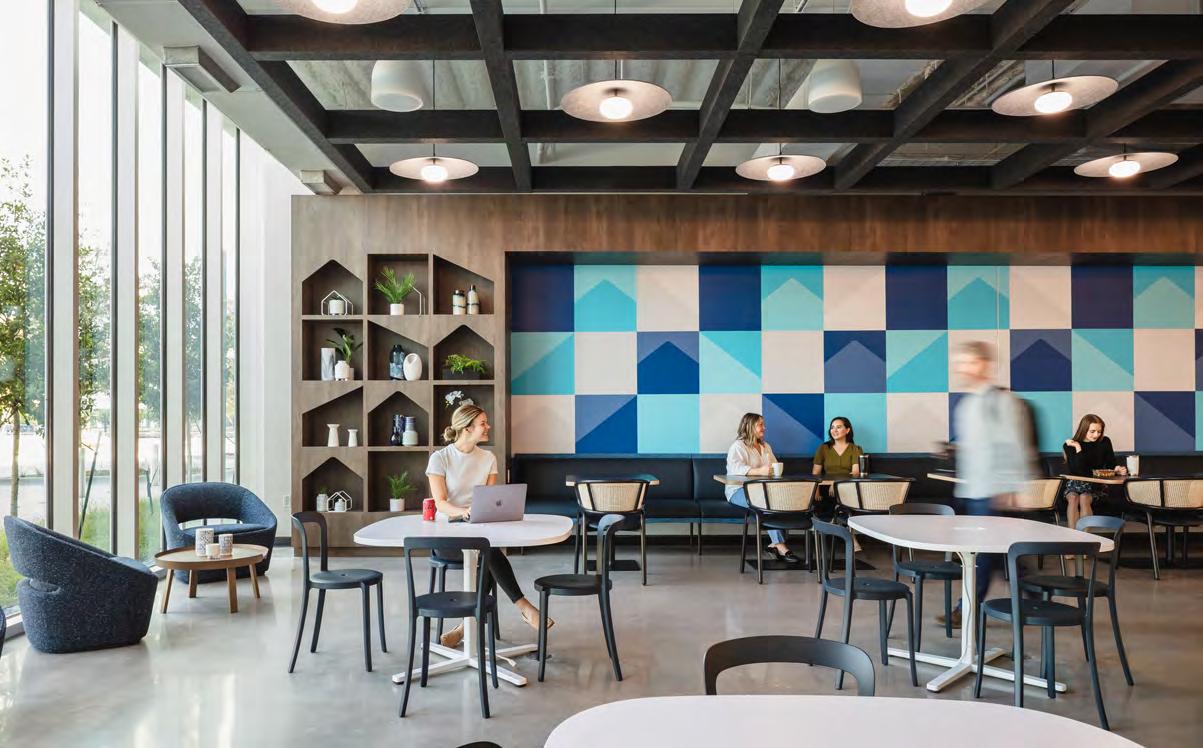
Drivers for Decision-Making
With a deeper understanding of the hybrid worker and how they currently operate, it is important to drill down what informs hybrid workers’ decision to be in-person or remote each day. What personal and professional drivers inform decision-making? How can our offices meet additional needs and preferences that are currently only available in remote work environments?
DRIVERS FOR WORKING IN-OFFICE
The top drivers for working in the office include: access to office-wide technology, personal desk setup, additional space, team meetings, and overall design aesthetics. For going into the office, technological resources and connecting with others in the space is key. The affordances of space are also attractive, such as space to spread out and the overall look and feel of the space.
Drivers for coming to the office center around function of technology and space and the expectation and perception of attendance.
Survey participants were also able to indicate if there were any other drivers that they consider when choosing to go into the office. The drivers they shared include close proximity to their team (n=5) and provided snacks (n=4).
DRIVERS FOR WORKING REMOTELY
The top drivers for working remotely include reduced commute, health and safety, personal desk setup, ability to control environment, and flexibility to address work and personal responsibilities. Unsurprisingly, hybrid workers prefer to skip the commute and avoid the office when they aren’t feeling well instead of taking time off.
Having this control ultimately impacts a worker’s perceived productivity and are important to also provide in the office.
Drivers for working remotely center around necessary autonomy and control — to protect time, health, and environmental quality.
While being closer to team members is the main driver for going to office in the “Other” category, spending time with pets (n=3) and being able to rest and take a break (n=5) are additional drivers for people wanting to work from home.
HIGHEST RANK
Drivers for Working Remotely Drivers for Coming into the Office
Reduced Commute Time
Health and Safety
Personal Desk Setup
Ability to Control Environment
Flexibility For Work/Personal Responsibilities
Lack of Dress Code
More Time with Friends/Family
Overall Design and Aesthetics
Increased Focus and Productivity
Ability to Travel
Lower Stress Environment
Avoiding Office Politics
Increased Focus on Mental/Physical Wellbeing
Other
Access to Office-wide Technology
Personal Desk Setup
Additional Space
Team Meetings
Overall Design Aesthetics
Office Events
Proximity to Collaborators/Team Members
Access to Workplace Amenities
Change of Environment
Impromptu Collaboration
Professional Development Opportunities
Mentorship
Increased Visibility
Private Focus Space
LOWEST RANK
NEIGHBORHOOD ASSETS
Neighborhood assets near the office and home play an important role for hybrid workers by offering third places for convenience, connection, focus, and wellbeing. Survey participants ranked the importance of neighborhood assets they look for near both the office and home.
Survey participants indicated wanting similar assets near both the home and the office, such as restaurants, shopping, and green space. Parking
access is also highly desired near both the office and home, indicating a desire for a shorter, and more streamlined commute between.
There is a preference for activities/hobbies near the home, indicating interest in consistent, easy access to these activities even when working from home. While near the office, coffee shops are preferred, offering a space and activity to go to for breaks and social engagement away from the office.
What kinds of neighborhood assets do you look for?
NEAR THE OFFICE
1. Parking Access (3.98/5)
2. Restaurants (3.68/5)
3. Coffee Shops (3.68/5)
4. Shopping Options (3.64/5)
5. Green Space/Nature (3.63/5)
6. Mass Transit Access (3.62/5)
7. Quiet Escape (3.58/5)
8. Doctors’ Offices (3.58/5)
9. Fitness Centers (3.50/5)
10. Event Space/Conference Space (3.49/5)
11. Extracurricular Activities/Hobbies (3.47/5)
12. Architectural Attractions (3.45/5)
13. Museums/Cultural Attractions (3.37/5)
14. Live Music (3.36/5)
15. Pet Care (3.33/5)
16. Childcare (3.29/5)
17. Dog Park (3.23/5)
NEAR HOME
1. Restaurants (3.96/5)
2. Shopping Options (3.89/5)
3. Parking Access (3.87/5)
4. Green Space/Nature (3.85/5)
5. Extracurricular Activities/Hobbies (3.81/5)
6. Doctors’ Offices (3.78/5)
7. Quiet Escape (3.78/5)
8. Fitness Centers (3.70/5)
9. Coffee Shops (3.68/5)
10. Mass Transit Access (3.65/5)
11. Pet Care (3.57/5)
12. Museums/Cultural Attractions (3.55/5)
13. Architectural Attractions (3.51/5)
14. Live Music (3.51/5)
15. Childcare (3.50/5)
16. Dog Park (3.45/5)
17. Event Space/Conference Space (3.34/5)

Workplace Design
AMENITIES
Building amenities impact the overall building size, design, operations, and the “stuff” within it. In this study, we wanted to dive deeper to understand not only what is important to hybrid workers, but what ultimately predicts their satisfaction within these categories.
Following the COVID-19 pandemic, companies made a concerted effort to attract employees back to the office. This was often done by affording employees spaces and services that they don’t have at home, such as catered lunches, social and cultural events, new communal and recreational spaces, or wellness facilities and classes. As we shift from the initial need of getting people back into the office, to creating a lasting, successful, flexible work environment, we asked survey participants to share what amenities are most important for them to have access to in the workplace.
Top 5 Important Amenities
1. Functional office technology (3.99 out of 5)
2. Effective IT help desk (3.97 out of 5)
3. Parking (3.89 out of 5)
4. Access to natural daylight (3.86 out of 5)
5. Abilit y to control environmental quality (3.76 out of 5)
Attracting employees to the office isn’t just about the space program available, it is also about the technology available and its subsequent support. When categorizing the amenities, technology based amenities (e.g., functional office technology, such as docking resources, or an effective IT help desk) are the most important to survey participants, followed by space-based amenities (e.g., wellness rooms), environmental quality (e.g., ability to control temperature, lighting, sound), and service-based amenities (e.g., catered lunch).
These findings differ depending on time spent in office and what size company an employee is working for. Hybrid workers who come in 4-5 days a week rank the overall importance of amenities
higher than those who come in 3 days or less. Also, hybrid workers who come into the office fewer days a week are more likely to rate technology as more important than employees who spend more time in the office.
Results also showed that hybrid workers at medium sized companies (100-1,000 employees) tend to rank the importance of amenities that require additional space significantly lower than those at larger companies (1,000-2,500 employees, 2,500+ employees). In medium-sized companies, technology-based amenities are the most important to employees. As the company size grows, the level of importance and the priority for space type amenities grows as well.
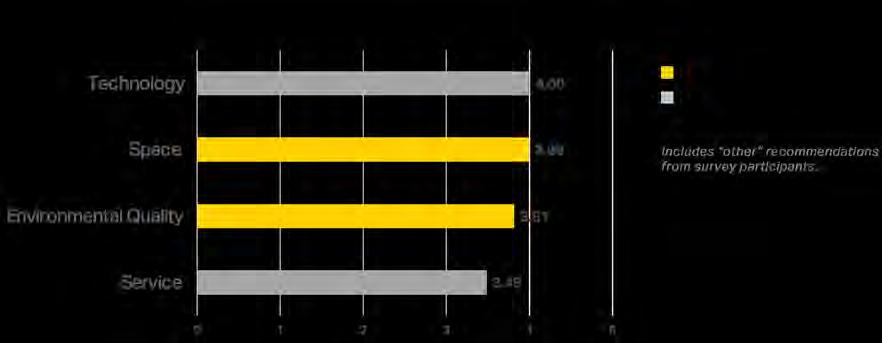
KANO MODEL
One important question always discussed when considering workplace design is “What amenities do I need to include?” The majority of survey participants identified all amenities as moderately to very important, indicating an appeal for whatever is offered. So how do we differentiate between desires and expectations to predict attraction and utilization of space?
In order to make these types of differentiations, we used the Kano Model to help prioritize amenities based on how likely they are to satisfy hybrid workers.4 This model defines features based on functionality and subsequent user satisfaction to build a more time sensitive, strategic approach to investment. Our research participants reviewed the following amenities and through the Kano analysis, we identified what spaces, technologies, and services are most likely to impact satisfaction.
ATTRACTIVE
Outdoor Space/Nature
Wellness Room
Catered Lunch
On-Site Cafeteria
Gym Access
On-Site Fitness Room
FUNCTIONALITY SATISFACTION
PERFORMANCE
Free beverages/snacks
Ability to Control Environmental Quality
MUST BE
Access to Natural Daylight
Effective IT Help Desk
Functional Office Technology
Parking
INDIFFERENT
Lifestyle Amenities
Shipping/Receiving for On-site Personal Deliveries
On-site Daycare Center
Murals & Art Installations
On-site Medical Center
Cutting Edge “Green Practices”
Game Area/Ping Pong Tables/Arcade Games
ATTRACTIVE: delight features that can only provide satisfaction as they are unexpected.
PERFORMANCE: desired features that workers want that directly impact satisfaction.
Local/Small Business Food & Drink
Exterior Patios & Balconies
Event Space/Conference Space
MUST BE: basic features expected in an office that only negatively affect satisfaction.
INDIFFERENT: features that are neither good nor bad and don’t impact satisfaction.
Survey participants were also able to enter “other” amenity spaces that they find important to have in the workplace. Of those shared, there is a strong desire for more spaces catered to comfort and relaxation, such as rest space and lounges, in addition to wellness rooms.
■ Rest space (36)
■ Lounge (30)
■ Restaurant (17)
■ Game Room (14)
■ Pet Care (14)
■ Massage Room/Chair (10)
Values are indicative of the number of participants who listed that specific additional amenity option.
In a study from Staples in 2014, 85% of employees indicated that taking breaks throughout the day improves their productivity.5 However, more than a quarter of employees don’t take breaks during the day other than lunch due to guilt and feeling that they can’t leave their desks. Separate space in the workplace supporting worker wellbeing and breaks can ultimately promote additional productivity.
CUTTING-EDGE GREEN PRACTICES
In our 2021 study, Workforce Blurred, outdoor green space was the second most selected on-site work amenity (73%), while cutting-edge green practices ranked fourth (64%). This desire from the incoming generation of workers to work for companies with values aligned with their own will challenge companies to create a future-forward identity that not only benefits the environment, but also attracts talent.
Our most recent study of hybrid workers of all ages found that survey participants still considered cutting-edge green practices (3.5 out of 5) as an important amenity. But what defines a cutting-edge green workplace? What is most important?
The most important features are ones that allow employees to contribute to a cutting-edge green workplace and a building that operates on renewable energy.
QUALITIES FOR FOCUS WORK
While private focus space is the lowest ranked driver for hybrid workers deciding to come into the office, increased focus and productivity is also not a main driver for working remotely. However, personal desk setup is ranked highly as a driver to work from home and from the office. This indicates that the affordances of a personal desk set-up are key for focus and productivity, giving hybrid workers their ideal, and familiar, personal set-up wherever they choose to work.
Providing well-designed spaces that meet individual needs and preferences can help employees to be productive. Without this, hybrid workers will continue to seek other options
Top Spatial Qualities Hybrid Workers Desire for Focused Work at any Location
for working when they need to be productive individually. Surveyed hybrid workers indicated that the top 3 spatial qualities they look for to complete focus work at any location are quiet (50%), proximity to necessary resources (39%), and the ability to control their environment (e.g., lighting, temperature).
Following the top 3 are views to outdoors/natural lighting (31%) and visual privacy (26%) indicating a need for curated views when completing focus work. This can be to either improve the quality of space or to provide privacy from others, offering choice and personalization. These visual needs are rated more highly than acoustical privacy, indicating a higher concern for being seen over being heard.
Virtual + Physical Seamlessness
Seamless integration of virtual and physical aspects of the hybrid workplace can create an environment where employees collaborate, communicate, and produce regardless of where and when they are working. When asked about the physical and virtual workplace, 85% of survey participants indicated that they see it as a seamless hybrid work environment instead of separate physical and virtual work environments.
In addition, 81% of survey respondents indicated that they primarily think of the workplace as a virtual
environment with physical spaces connecting to it. This indicates that when thinking about the workplace in a hub and spoke model, the virtual environment is the connector between various physical work environments.
For today’s hybrid workers, the concept of seamlessness goes beyond mere connectivity; it signifies the need to bridge the gap between physical and virtual, allowing employees to be productive, while also fostering relationshipbuilding and culture, regardless of their location.
How do hybrid workers describe the hybrid workplace?
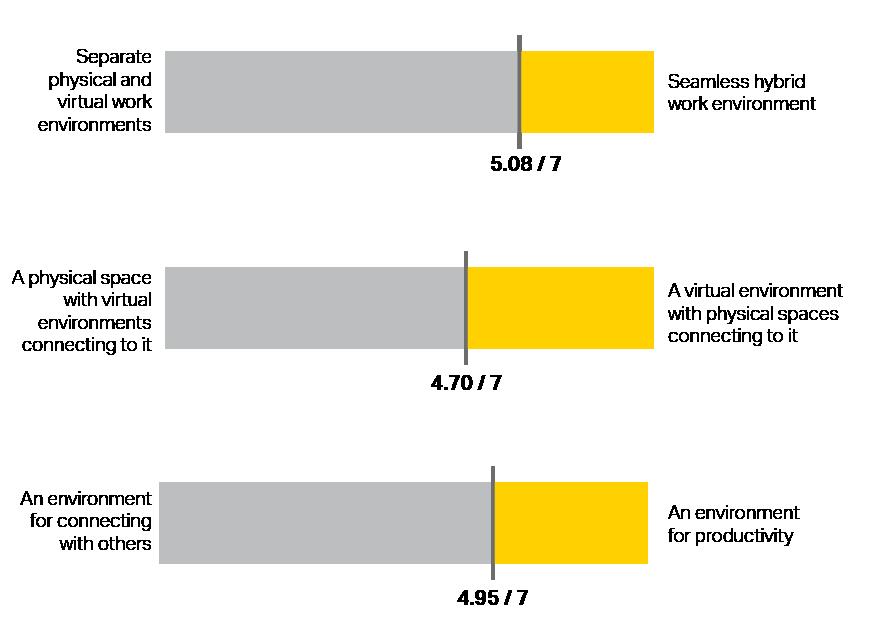
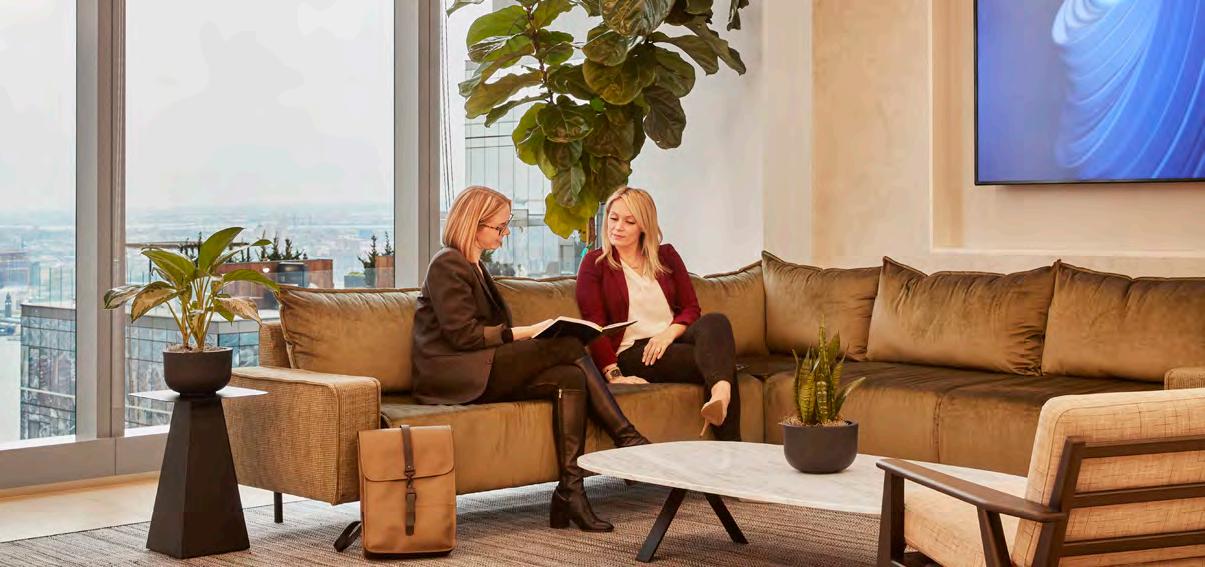
Attraction + Retention
Over the past few years, many terms have been coined about employee attraction, engagement, and retention — the great resignation, quiet quitting, working your wage, and many more. While these terms bring attention to specific issues, they often overlook underlying causes, or more importantly, drivers for success for both companies and their employees.
From our survey of hybrid workers, we found that:
1
2
Having flexible working hours plays an important, statistically significant (p=6.5E-4), role in the employees’ willingness to stay with the company for longer time.
There is a high correlation between people who have been spent the last 3-5 years at a company and those who intend to remain at that same company for at least 6-9 years.
3
As the number of years an employee has worked at a company increases, so does the feeling of being more productive working from locations other than office.
This indicates that employees who were with their company prior to the COVID-19 pandemic, plan to stay at that same company longer compared to employees who started in the last 0-3 years working remotely.
It is of increasing importance that as employees join a new company, they are supported in building relationships with colleagues, becoming involved in the company culture, and being immersed physically to promote increased familiarity, trust, and overall comfort. This is key for success and productivity not only at the office, but also working where and when they want and need to.
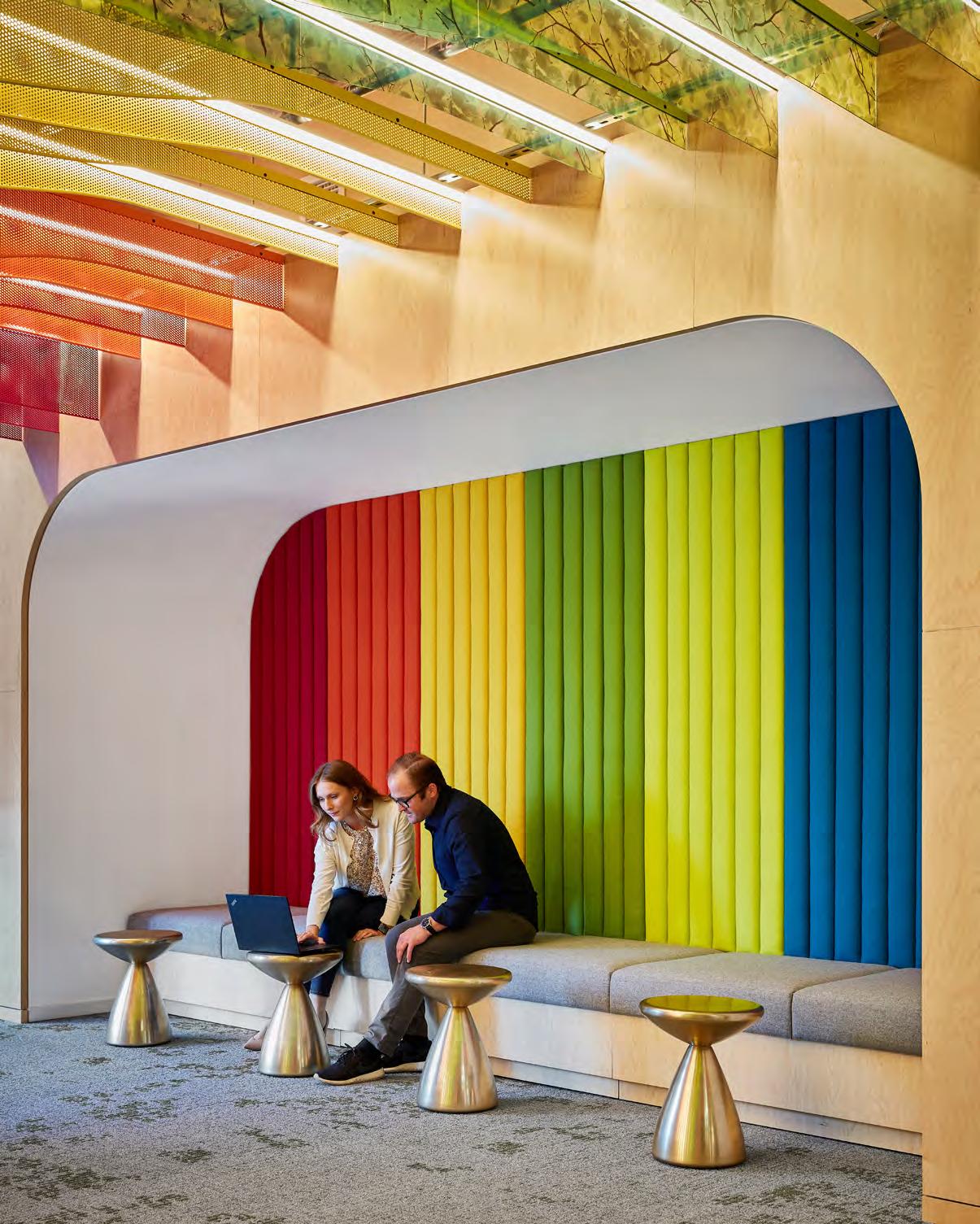
The Generational Divide
This survey of hybrid workers targeted people who were born either between 1965-1980 (Gen X), 19811996 (Millennials), or after 1996 (Gen Z) to represent key age groups who experienced the shift to hybrid work and will continue to participate in shaping how it will operate in the future.1 Each generational sample was also divided into younger and older groupings (e.g., younger and older Millennials) during survey analysis to understand if there were additional differences among each generation.
1
Flexible working hours are less important to older generations than flexible location. While flexible working location is of high importance to all, Older Gen X hybrid workers rate the importance of flexible working hours less important than younger Gen X, Millennials, and Gen Z (p=5E-4).
Gen X also takes advantage of flexible work locations (typically coming to the office 2-4 days per week) more often than younger generations (typically coming to the office 3-4 days per week).
3
Providing technology support is important in meeting the needs of Gen X.
Gen X rates technology-based amenities (e.g., IT help desk) higher than other generations. While all generations indicated that they were able to adopt new technology when starting remote work during the COVID-19 pandemic, continuing support and resources is needed to provide additional comfort in the adoption process for older generations.
While there are distinctly different desires and experiences associated with each generation in the hybrid workplace, survey findings indicate that these generations in the hybrid workplace are more similar than dissimilar. Despite variations in attitudes, values, and technological fluency, there are fundamental perspectives that surpass generational boundaries.
Based on insights gathered in this survey, these key areas are where generational perspectives exhibited significant variations:
2
Gen Z likes more flexibility and are the least satisfied.
Gen Z hybrid employees like more flexibility overall, both in terms of hours and location as compared to the other generations. Based on current policy implementation, Gen Z is also the least satisfied of the generations with their current company flexible policies and flexible working hours (p=7E-3).
Gen X and Millennials rate the importance of the design of the workplace in building relationships higher than other generations.
4
Personal preferences in amenities are driven by generational life stage. While on-site daycares as an amenity were considered indifferent (neither good or bad) overall, their level of importance changes when looking generationally. These were rated more important among Millennials –which is the generation most likely to have small children. Certain amenities should be considered based on make-up of a company’s hybrid workforce.
Findings from Workforce Survey
01
LEVELING THE GAP BETWEEN THE HOME AND OFFICE
As the lines between in-office and remote blur, it essential to confirm both environments meet the same fundamental needs of hybrid workers. Regardless of work environment, hybrid workers desire similar amenities and neighborhood assets. They also need focus space to complete work tasks, connect with colleagues and resources, and have time and space for respite in both locations.
02
UNLOCKING PRODUCTIVITY WITH MOTIVATION AND OFFICE AFFORDANCES
The office is not currently productive — and the hybrid workforce wants and needs it to be. There is additional motivation felt when working in a group or seeing others working. Top spatial qualities needed for focus are more often afforded at home than in the office. By incorporating these space types and qualities, more opportunities to get work done will be created.
03 BROADENING THE DEFINITION OF FLEXIBILITY
Flexibility is a term that means different things to different people in a variety of circumstances. For hybrid workers, flexible time is just as important as flexible location. Personal preferences are driving decision-making overall — for policy but also spatial design and environmental affordances. Flexibility accommodates the diverse needs and preferences of hybrid workers for focus work and respite.

04
EMBRACING CHOICE AND OWNERSHIP
Equal to providing options and flexibility for hybrid workers is offering choice and establishing ownership in the workplace. Personal desk setups (a reliable place set up for hybrid worker needs) and the ability to control the environment (e.g., temperature and lighting control) are important to bringing people to the office. Approaches like hot desking or an operations-controlled environment might lend to more hybrid workers choosing to focus from home where they have their ideal setup and the ability to adjust based on their comfort and needs.
05
BALANCING VISIBILITY AND VISUAL PRIVACY
While being physically present in the office can enhance visibility and promote collaboration, it’s equally important to recognize that hybrid workers require periods of uninterrupted concentration to accomplish their work. Providing spaces or flexible design offering visual privacy allows hybrid workers to maintain focus while still benefiting from the social connections that come with in-person interaction.
06
BUILDING BONDS, SHAPING CULTURE, GETTING ESTABLISHED
Hybrid workers who joined their company prior to the COVID-19 pandemic tend to have a longer tenure, highlighting the importance of in-person interaction during the initial stages of joining a company. However, establishing oneself within a company is not solely dependent on the length of time spent there. It revolves around building relationships with colleagues, becoming part of the company culture, and building familiarity with resources, all of which hybrid workers consider important to occur in the built environment.

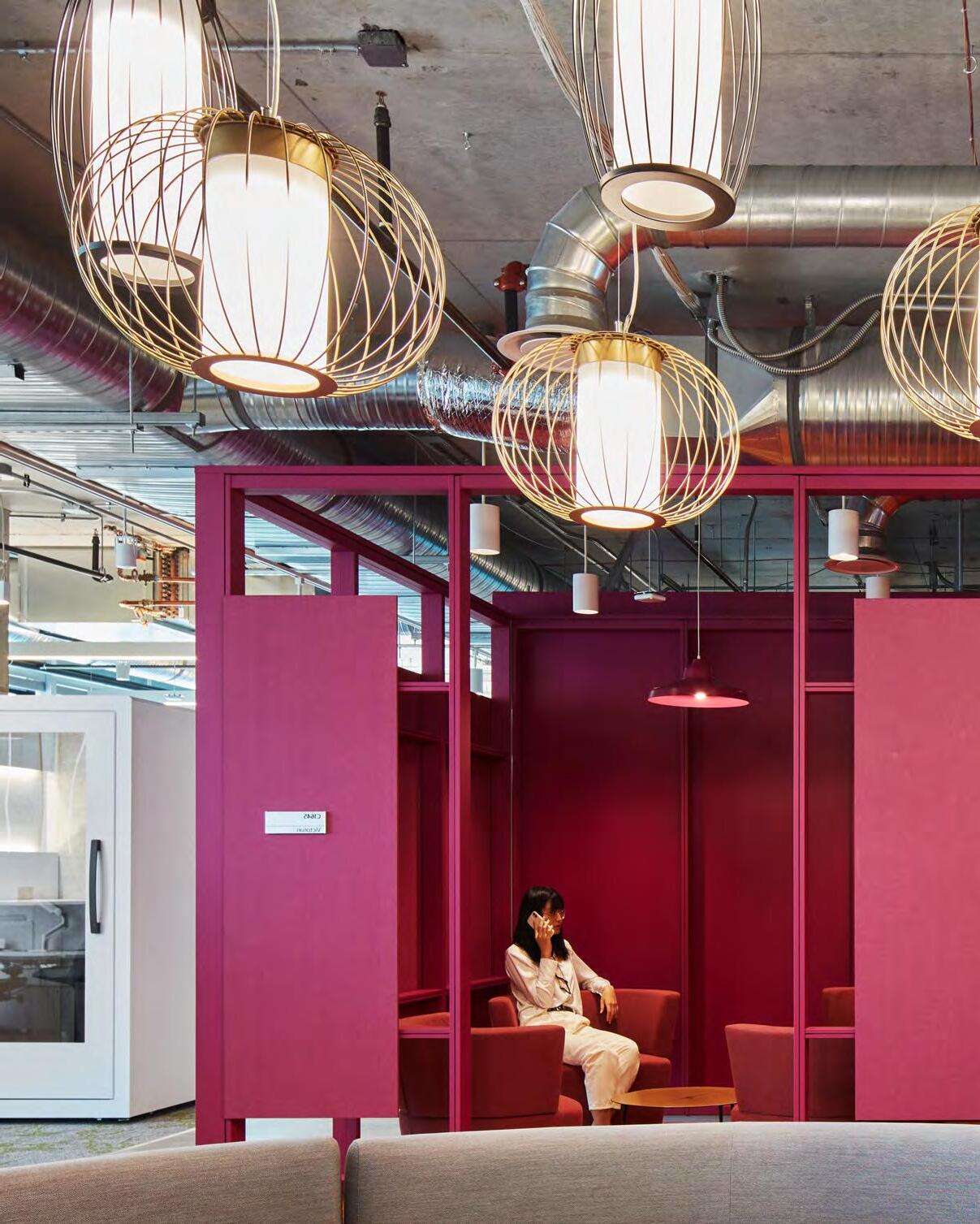
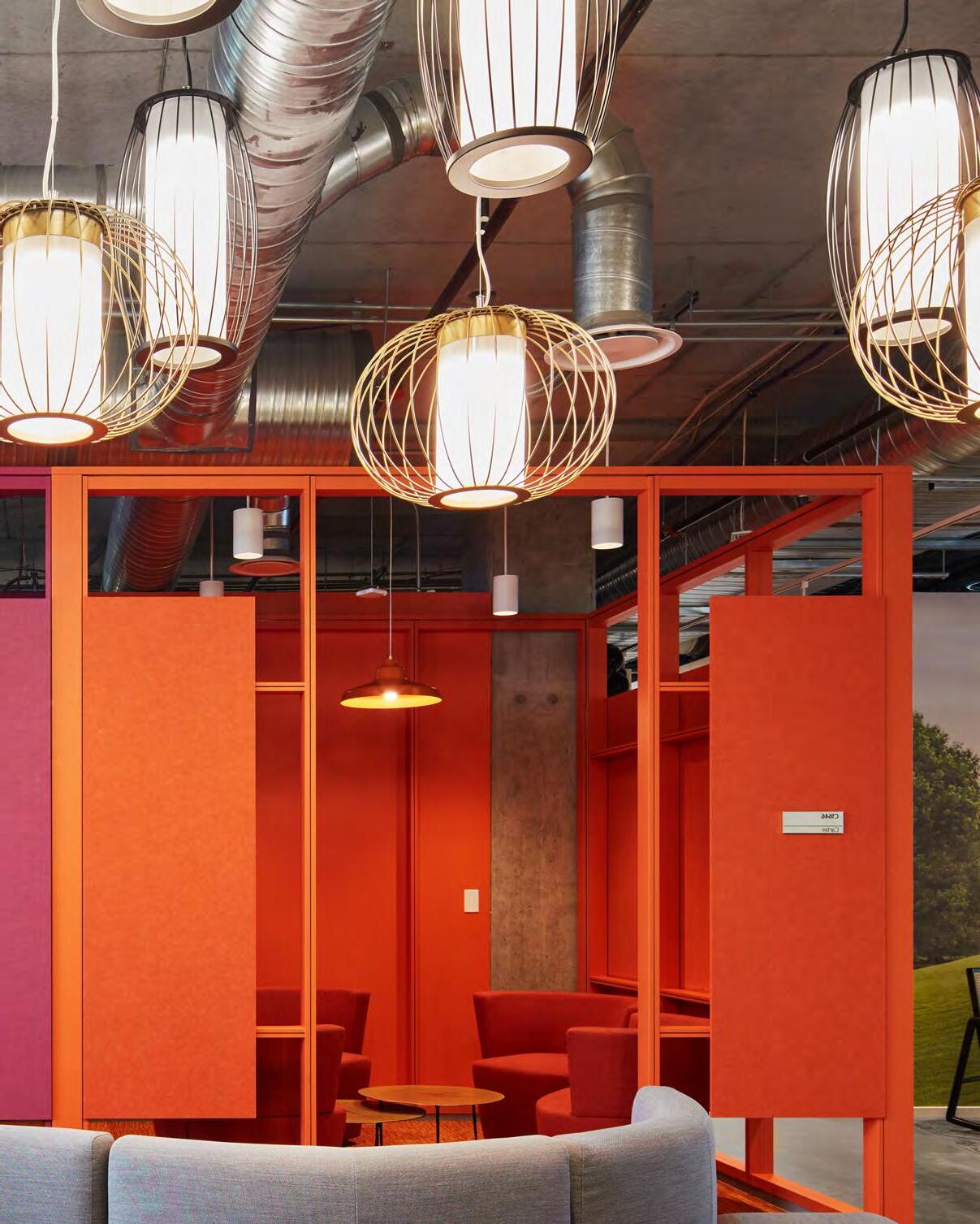
Conclusion
Value of the Hybrid Workplace
By understanding the unique characteristics, needs, and challenges of hybrid knowledge workers, organizations can effectively adapt their strategies, policies, and practices to create an environment that supports productivity, engagement, and wellbeing in the hybrid work landscape.
The hybrid workforce has distinct values that contribute to a productive, balanced, and fulfilling work experience in any environment. These include:
1
CONVENIENCE
Ease of commute and the ability to access people and technology when needed.
FUNCTIONALITY
Basic functionality and availability of technology and space impact employee workspace satisfaction.
3
2 4
5
PEOPLE
Encourage relationship building to retain talent and build a desirable office culture.
PRODUCTIVITY
The design of spaces should be in alignment with personal needs for focus.
COMFORT
The environment should be equal to or better than what’s available to employees at home.

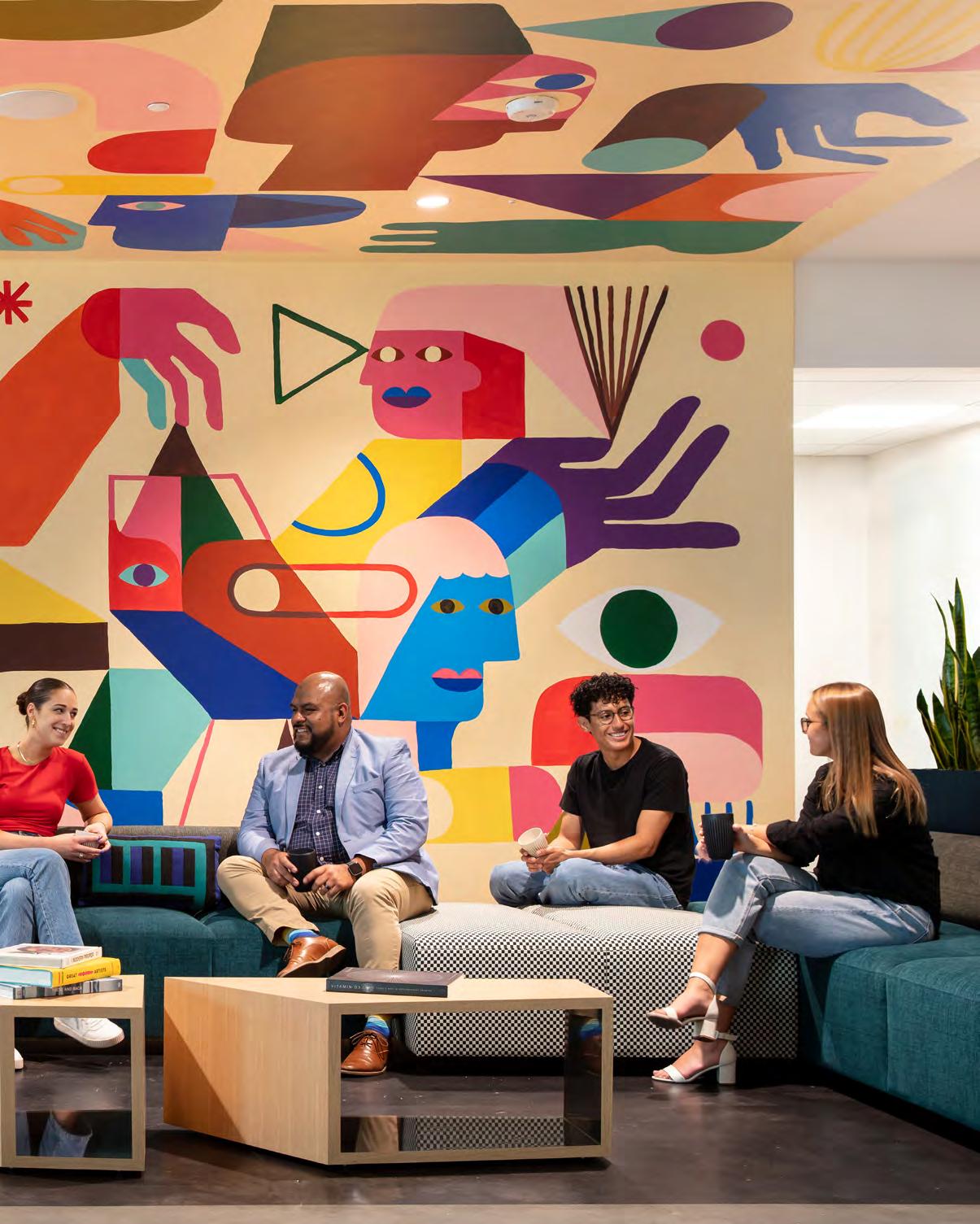
Designing the Hybrid Workplace
FOSTERING RELATIONSHIPS THROUGH DESIGN
Design matters for bringing people together — not only through general proximity to each other, but by creating opportunities for connection and motivation.
DESIGN STRATEGIES
1
2
3
Create spaces for people to have experiences together besides work, such as outdoor spaces or areas to eat lunch together.
Provide space for teams to hold meetings and collaborate in person; consider dedicated team spaces to provide ownership and desired personalization.
Design opportunities for accidental connections in space such as connecting stairs, wider hallways, multi-purpose event spaces, and common areas, allowing for impromptu run-ins to flourish.
DESIGNING FOR INDIVIDUAL AND TEAM PRODUCTIVITY
The office is important not only for team engagement, but also make sure individuals can balance personal productivity and team collaboration similarly to how they can in their remote work environments.
DESIGN STRATEGIES
1
2
3
Provide solutions for audio and visual privacy, especially within open office spaces where individuals spend most of their time.
Offer a variety of spaces in the office, encompassing different scales and purposes for both teams and individuals, accommodating diverse work styles and needs.
Consider spatial quality and affordances to provide comfort and ease, such as natural light or close proximity to required resources.


ENHANCING IN-PERSON UTILIZATION AND ENGAGEMENT
Increased office utilization can be achieved by providing a sense of ownership, catering to basic needs, and creating a comfortable and motivating environment.
DESIGN STRATEGIES
1
2
3
Increase autonomy and control in the work environment by providing usercontrolled elements in space, such as window shades and lighting controls to support individual comfort needs.
Focus on addressing the basics in space — removing barriers around technology and providing well-balanced, human centered workplaces.
Continuously strive to understand what amenities will attract staff to the office by creating a sense of “awe” and enhance their overall user experience over time.
SEAMLESSLY CONNECTING THE PHYSICAL AND VIRTUAL
Seamlessness goes beyond connectivity — it’s the need to bridge the gap between physical and virtual realms, making sure employees can collaborate, communicate, and contribute effectively, regardless of location and its affordances.
DESIGN STRATEGIES
1
2
3
Create the ability to connect via technology in all environments, not just the individual workstations, to maximize utilization of unique space offerings while being inclusive of remote workers.
Provide flexibility in the workplace design to better accommodate different team make-ups in terms of size and location and to transition between in-person and virtual interactions.
Consider office spaces on a continuum, with some being geared more towards virtual connection and others more towards in-person connection to better facilitate different needs.
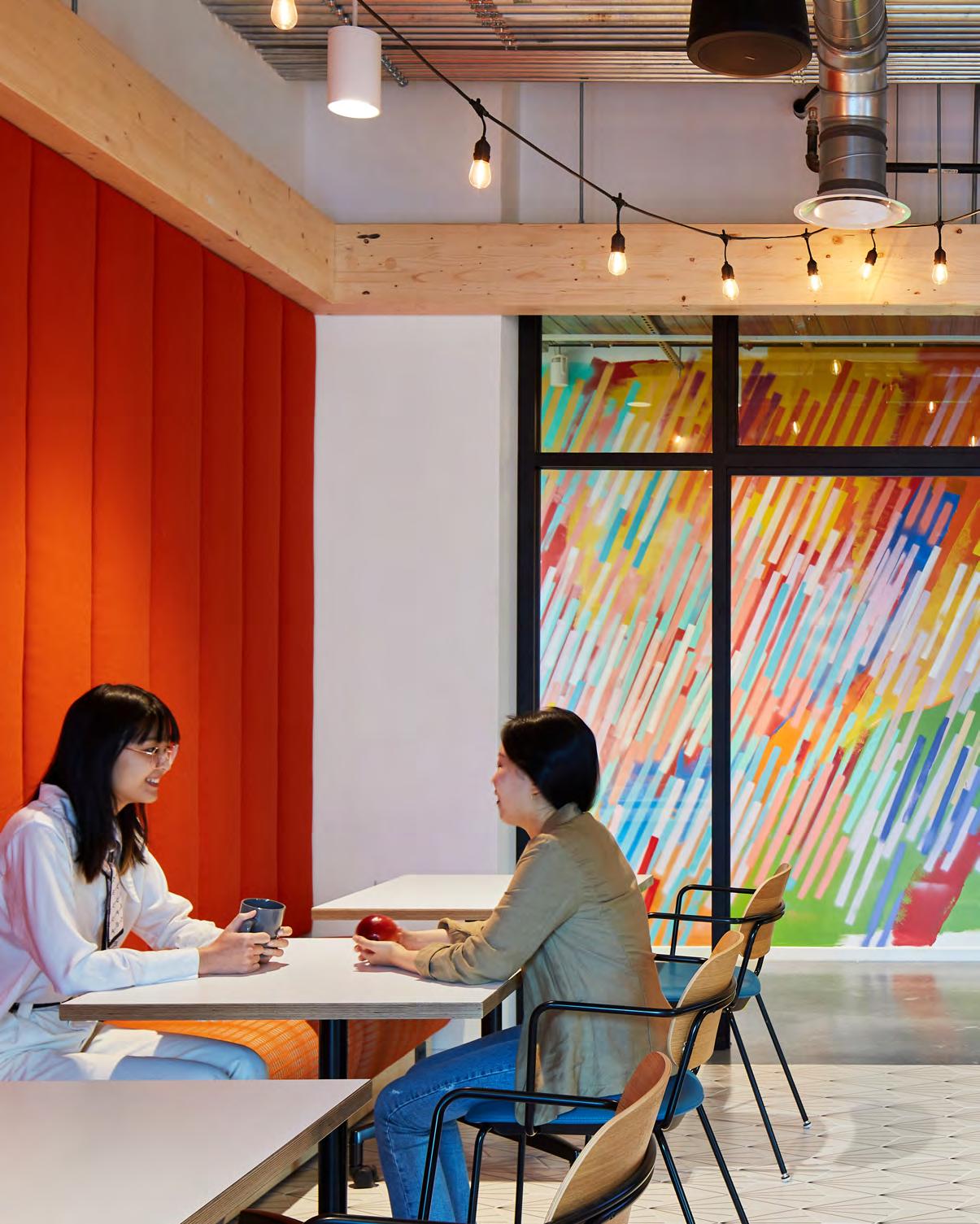
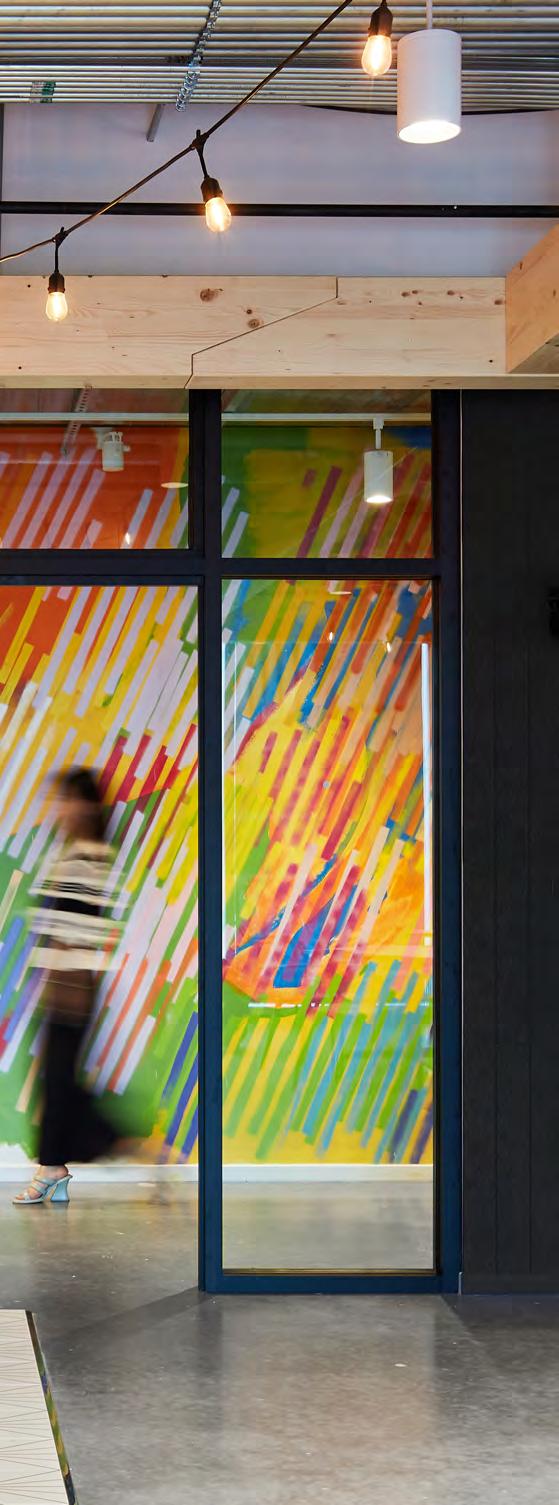
Limitations + Next Steps
In this study, we focused on the hybrid work environment and its users from the leadership and workforce perspectives. Other areas for future exploration could include deeper exploration on actual space design and utilization to build on upon self-reported insights.
Additionally, in analyzing the gender composition, it was observed that there was a significant disparity in the representation of genders other than male and female. Specifically, the proportion of individuals identifying as non-binary or gender nonconforming was notably lower, indicating a potential lack of inclusivity and representation in the sample. Further investigation and consideration of gender diversity is needed in future research endeavors.
Next steps for this study are to further investigate different hybrid worker groups (age ranges, genders, preferences, etc.), as well as to ideate and evaluate design innovations for a hybrid workforce.
Acknowledgments
Thank you to all of those involved not only on this study, but on the larger workplace research series. Your questions, collaboration, and insights drive our research and help us to jump into the future!
Corgan
HUGO RESEARCH AND INNOVATION TEAM
Melissa Hoelting, Assoc. AIA, WELL AP, Associate and Senior Design Research Lead
Mahdi Afkhami, PhD, LEED Green Associate, RESET AP, Design Researcher
Samantha Flores, AIA, NCARB, RID, Vice President and Director of Hugo
Abe Desooky, Assoc. AIA, LEED Green Associate, Design Researcher
CORGAN WORKPLACE STRATEGY AND INTERIORS TEAM
Emily Strain, Vice President and Director of Workplace Strategy
Lindsay Wilson, President and Interiors Market Sector Leader


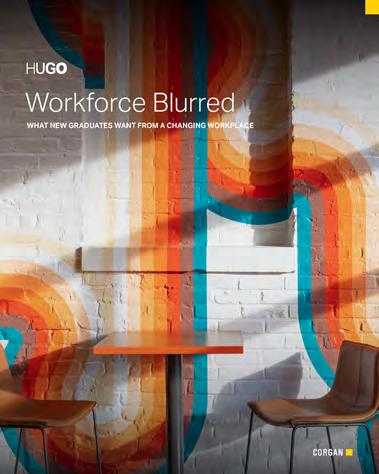
Work. Place. Blurred (2020)
Workforce Blurred (2021)
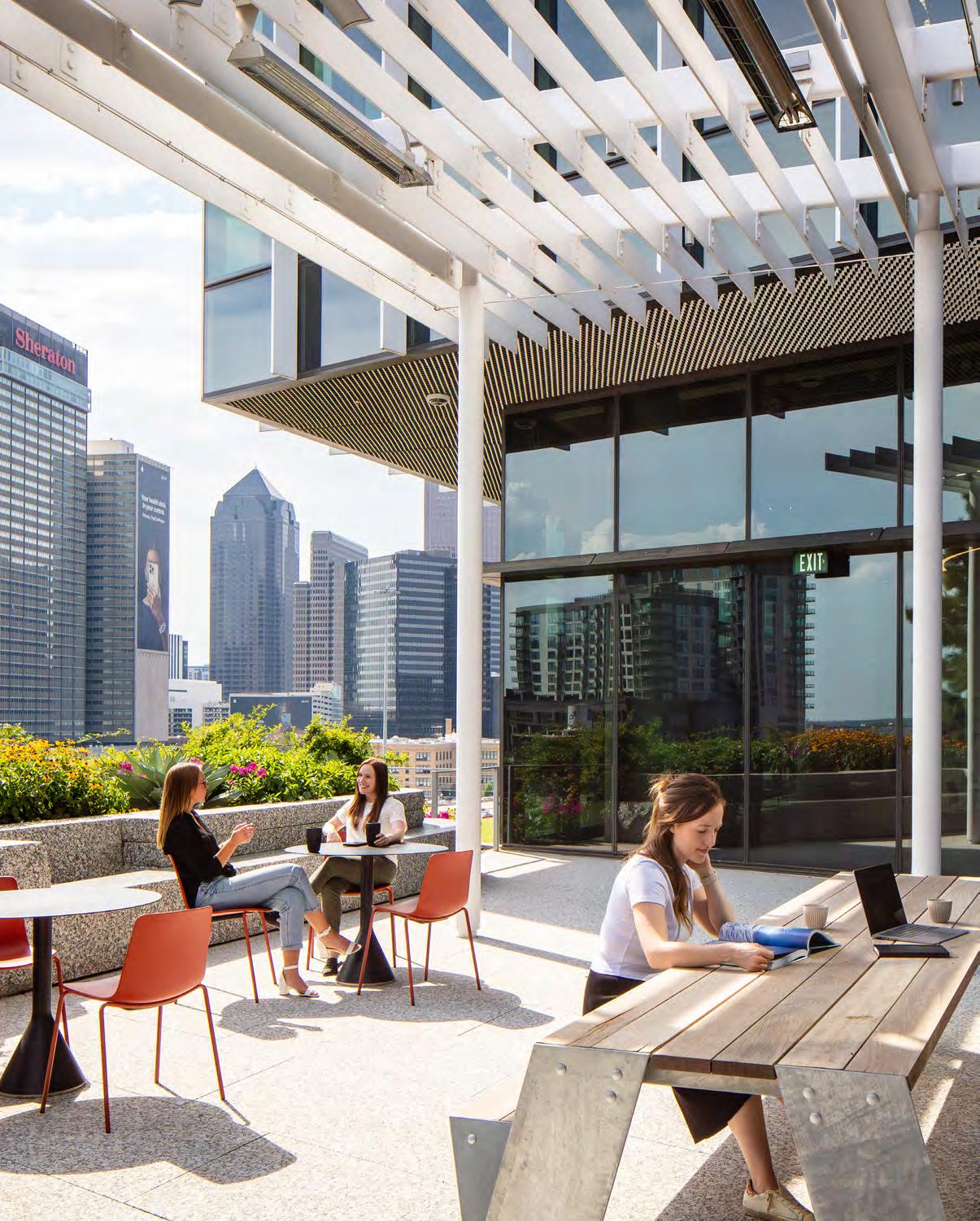


References
RESEARCH CONTEXT
1. White, T., & Flores, S. (2023). Workforce Blurred. Retrieved from Corgan. https://www.corgan.com/sites/default/files/inline-files/CorganWorkforce-Blurred.pdf
2. Accenture. (2023, May 27). The Future of Work. Retrieved from Accenture. https://www.accenture.com/us-en/insights/consulting/ future-work
3. 25 trending remote work statistics [2023]: Facts, trends, and projections. (2023) Zippia. https://www.zippia.com/advzice/remote-work-statistics/
WORKFORCE INSIGHTS
1. Pew Research Center. (2018, March 1). Retrieved from Pew Research Center: https://www.pewresearch.org/st_18-02-27_generations_ defined/
2. Brower, T. (2022, June 14). The Connection Crisis: Craving Friends At Work And How To Bring Back Belonging. Retrieved from Forbes: https://www.forbes.com/sites/tracybrower/2022/06/14/theconnection-crisis-craving-friends-at-work-and-how-to-bring-backbelonging/?sh=59c81ede244d
3. Steinmetz, J., & Fishbach, A. (2020, May 28). We Work Harder When We Know Someone’s Watching. Retrieved from Harvard Business Review: https://hbr.org/2020/05/we-work-harder-when-we-know-someoneswatching
4. Kano analysis: The kano model explained. (2023). Retrieved from Qualtrics: https://www.qualtrics.com/experience-management/ research/kano-analysis/
5. Brooks, C. (2023, February 21). The Key to Increasing Productivity? Employee Breaks. Retrieved from Business News Daily: https://www. businessnewsdaily.com/6387-employee-breaks.html
